Competitive Assessment
Introduction
In both the perception of local stakeholders and visually through new and under-construction downtown developments, St. Petersburg is a city on the rise. Long-term residents often begin stories about St. Petersburg with, “if you would have seen this (fill in the blank) ten years ago, you wouldn’t believe how much it’s changed for the better.” Downtown and the waterfront are buzzing with activity and certain intown neighborhoods are seeing re-investment after years of decline. The city’s long-time economic strengths in tourism and construction are being complemented by growing concentrations in marine science, health care, professional and technical services, financial services, and the arts. But analysis of the data reveals some continuing concerns. The city of St. Petersburg and its home county of Pinellas are among the few Florida communities to have lost population in the previous ten years. Economic growth has also stagnated, even before the crippling effects of the Great Recession. The city has experienced losses in some higher-wage skills-based sectors, including information technology and manufacturing, as well as in historically strong sectors, such as retail, that presumably negatively impact city revenues. Poverty and crime remain stubbornly high and performance rates of many public school students frustratingly low. But – as symbolized by its logo “Mr. Sun” – the Sunshine City of St. Petersburg has a bright future if the momentum of its intown resurgence can continue to bolster outer districts and the gradual diversification of its economy can be accelerated. Positive signs abound in its entrepreneurial economy as an ecosystem builds around a host of key assets and skilled talent is attracted to the walkable and amenity-rich downtown. Ultimately, what many in the community would like to see is St. Petersburg better differentiate itself in the Tampa Bay area, improving prospects not only in the city but also the region as a whole. The Grow Smarter Initiative will seek to determine what makes St. Petersburg unique, how it can be developed and improved and, ultimately, how the city’s “story” can be told to potential investors and talent across the country and globe.
Overview
The St. Petersburg Area Chamber of Commerce and the City of St. Petersburg are embarking on a comprehensive process to assess and enhance the city’s competitive position to support quality, diverse economic growth now and in the future. As other cities in Florida and across the country focus more and more resources and attention on growing their economies, how St. Petersburg is positioned for quality growth is a critical issue to address. Comprehensive quantitative and qualitative research will help inform the development of a unified Grow Smarter Initiative Strategy, the culmination of an eight-month process. The Strategy will include recommendations to advance economic opportunity for all St. Petersburg residents and make the city a top destination for companies and talent. The phases of the Grow Smarter Initiative include:
COMPETITIVE ASSESSMENT
This Competitive Assessment will provide a detailed examination of St. Petersburg’s competitive position as a place to live, work, visit, and do business. Rather than simply describing data trends, the Competitive Assessment synthesizes key findings from the analysis and community input framing the discussion around key “stories” and competitive issues faced by the community. St. Petersburg trends will be compared against the cities of Durham, North Carolina; Jacksonville, Florida; and Orlando, Florida
TARGET BUSINESS ANALYSIS AND MARKETING REVIEW
Using the findings from the first phase, we often then review and define the business sectors that most strongly align with St. Petersburg’s competitive strengths. The Target Business Analysis will begin with an evaluation of the region’s workforce and then reviews existing economic strengths, global trends, and both obvious and “aspirational” job sectors. The goal of the Target Business Analysis is to identify how to diversify and strengthen the economy through entrepreneurship, existing business expansion, and recruitment. A Marketing Review will assess St. Petersburg’s principal marketing programs and tools
GROW SMARTER INITIATIVE STRATEGY
The Strategy will be holistic and inclusive of the many components that affect St. Petersburg’s ability to be a prosperous community. From business retention, expansion, and small business support to quality of life needs and educational programs that strengthen the talent pipeline, the Strategy’s ultimate goal areas, objectives, and actions would build on the findings from the research.
IMPLEMENTATION PLAN
While the Strategy represents “what” St. Petersburg needs to do, the Implementation Plan determines “how” to do it. The Implementation Plan will serve as the “road map” for putting the Strategy into motion. The Implementation Plan outlines the activities of the Strategy’s objectives on a day-by-day, month-bymonth, and year-by-year basis.
PUBLIC INPUT
Quantitative analysis in this Competitive Assessment report was supplemented by a comprehensive publicinput process. This included multiple focus groups, over 20 one-on-one interviews with top regional leaders, and an online survey available to all regional stakeholders that garnered 1,510 responses. Survey responses are provided in a separate document.
THE ST. PETERSBURG STORY
The quantitative and qualitative information gathered and analyzed for this Competitive Assessment led to the identification of certain key themes that can serve to help tell the city of St. Petersburg’s “story” in recent years. The components of this narrative not only address the community’s past, but also present questions for its future based on the identified realities, challenges, and opportunities that emerge from this assessment. In the end, the principal “takeaways” from this report will inform the subsequent phases of the Grow Smarter Initiative, ultimately leading to the development of the strategic and implementation plans themselves. The “chapters” of St. Petersburg’s story are:
- A Stagnant but Changing Population
- Returning to Residential Growth: Attractiveness to Existing and New Residents
- A Stalled but Evolving Economy
- Returning to Economic Growth: Competitiveness to Existing and New Businesses
A Stagnant but Changing Population
As St. Petersburg, Florida makes a gradual transition from a historical retirement destination – once pejoratively referred to as “God’s waiting room” – to a diversified economic hub, the city has experienced changes in its population dynamics, in terms of numbers and demographic makeup. Despite a highly regarded quality of life, both St. Petersburg and Pinellas County have shed residents (-0.7 percent and -0.4 percent, respectively), while all comparison geographies have experience population growth upwards of 25 percent.
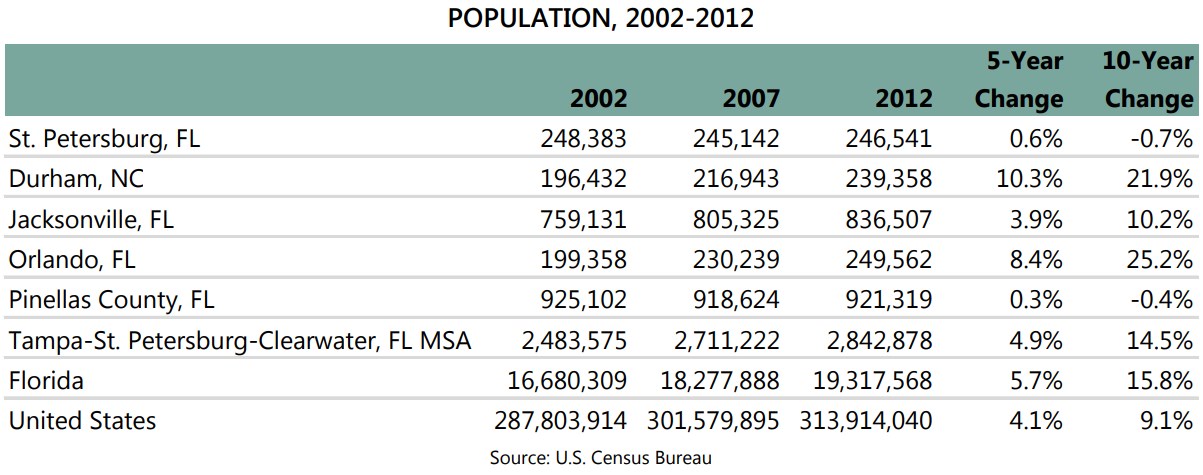
A deeper look into population components reveals that in Pinellas County, the source of population loss stems from natural change: there have been significantly more deaths than births countywide. It is worth emphasizing that Pinellas County is the only geography examined that experienced this negative natural change between 2000 and 2012

The city actually grew rapidly through the 1960s, but growth began to slow in the 1970s. St. Petersburg’s population growth has essentially been flat since 1980. The city of St. Petersburg and Pinellas County were particularly hard hit in the middle part of the 2000s. According to one input respondent, the community faced the “perfect storm” of higher property values, higher property taxes, and a steep increase in flood insurance due to the effects of Hurricane Katrina on policy rates in vulnerable coastal areas. St. Petersburg “became a place where no one could afford to live.” The next story will examine housing dynamics and other quality of life factors that influence residential choice.
As of 2012, the city of St. Petersburg’s population stood at 246,541, while Pinellas County’s population was at 921,319. With St. Petersburg comprising roughly 27 percent of the county’s total population, clearly the other Pinellas cities and unincorporated county have also seen stagnant growth. Both the previous table and the following chart starkly portray the difference between St. Petersburg’s and Pinellas’ growth curves versus this report’s comparison geographies.
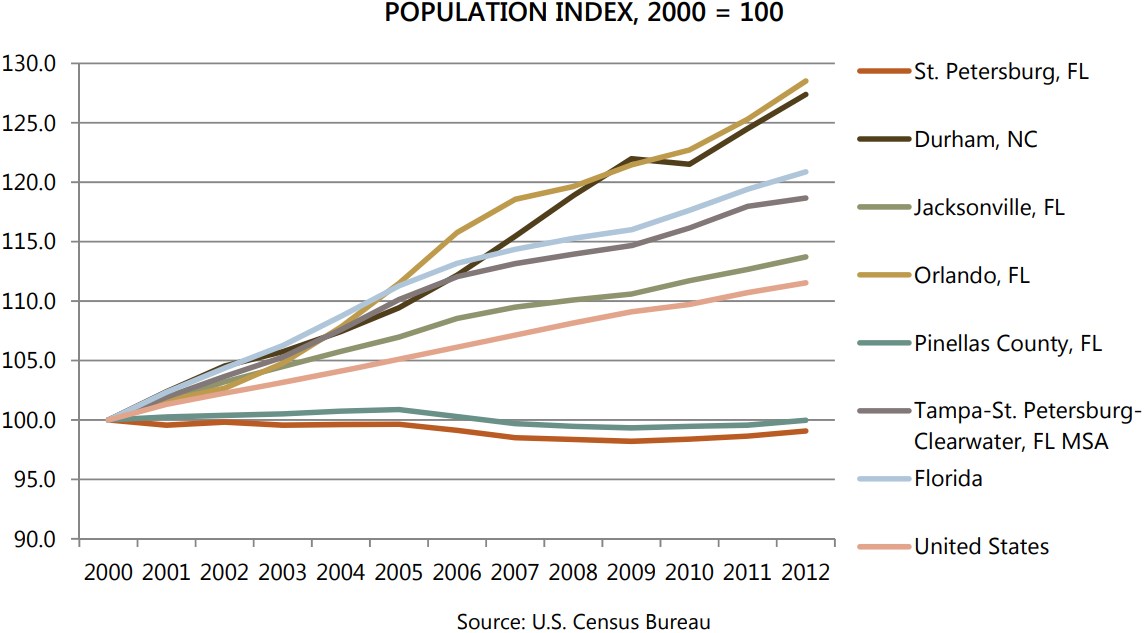
Age Dynamics
Driven by international migration, Pinellas’ impressive levels of positive net migration were not enough to overcome the effects of negative natural change, illustrated in a previous chart, which seems to reflect the community’s long history as a top retirement destination. This is reinforced by the much higher percentage of 65+ residents in St. Petersburg and Pinellas County than all the comparison areas.
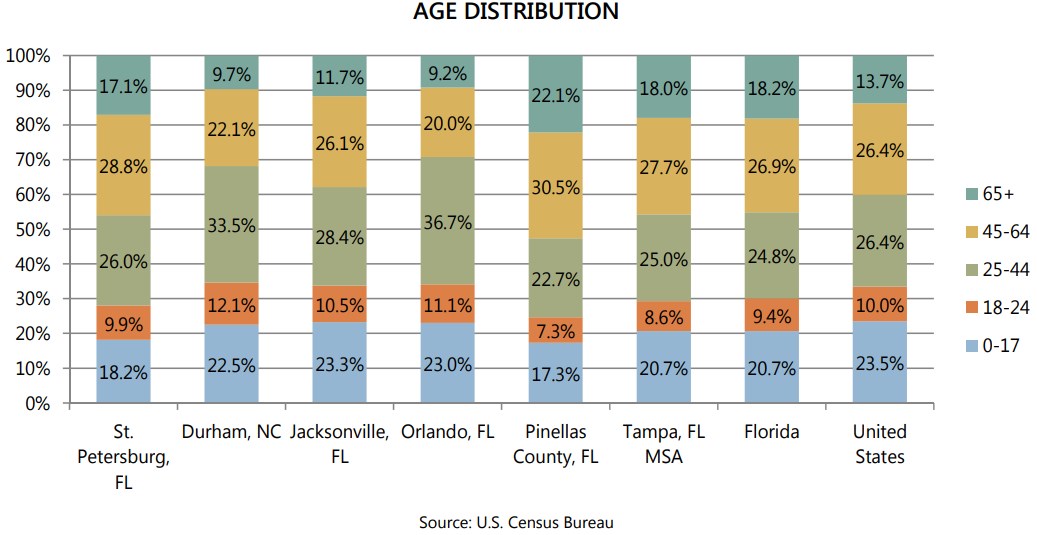
Looking at the other end of the age spectrum further illustrates why natural change has been negative. St. Petersburg’s 25-44 demographic, which captures the ages where many adults are starting families with children, represents a larger share of the population than the average Florida community (26 percent versus 24.8 percent), while children under age 17 represent a relatively small share (18.2 percent vs. 20.7 percent statewide). Accordingly, this suggests that the community has a relatively low birth rate; in fact, of 67 counties, Pinellas has the 15th lowest birth rate in the state.
These trends imply that, relative to the average Florida community, St. Petersburg is either more attractive to single or married young professionals without children and/or less attractive to young families that have or plan to have children. Supporting this hypothesis is the fact that only 21.1 percent of St. Petersburg households include children, compared to 24.8 percent of Florida households and 29 percent of U.S. households. Further, the average household size in St. Petersburg is 2.27, compared to 2.62 in Florida and 2.64 nationwide.
Public input provides evidence why fewer households in St. Petersburg have children under age 17. The two biggest challenges to talent retention and attraction mentioned by multiple input respondents were housing and public schools. One interviewee said it is “tough” for families moving to St. Petersburg to find a quality three-bedroom, two-bath house. When people ask, “Where’s your executive housing?,” the respondent said, the answer is, “That’s not really St. Pete.”
In terms of schools, perceived challenges in many local K-12 campuses was said to be a disincentive to live in St. Petersburg. One former higher education administrator said that issues with public schools were the “biggest reason we lost faculty.” Other respondents noted that school costs add “another tax” if your child does not place in a desirable charter or fundamental school.
These issues and other location factors will be explored in greater detail later in this report.
Though St. Petersburg has traditionally been known as a retirement destination, perceptions and realities of the city are changing. With a dense, compact built environment conducive to walkability, a revitalized downtown and waterfront, and other place-based amenities, St. Petersburg has become an increasingly popular regional destination for young professionals (YPs).
While young professionals said in public input that the St. Petersburg YP community is “very active,” they acknowledged that the network is lacking the “sophistication” of a Washington, D.C. or Atlanta. There is a lack of engagement with the broader community and entry into the YP network still requires the individual to be proactive. “There are plenty of ways to jump right in,” one YP said, “but the perception is that it’s hard. The reality is, you just show up.” Respondents said that the multitude of YP-focused groups that have cropped up in recent years are disjointed, without a real bond between the networks.
Changing generational demographics is also leading to reported community tensions between long-time residents and newcomers with different attitudes about St. Petersburg’s future. Input residents said there’s a “difference in vision between generations.” These perspectives crop up during discussions of options for the St. Petersburg Pier, reuse of Albert Whitted Airport, and Greenlight Pinellas, among others. One interviewee said of these tensions, “We are not necessarily a ‘nimble’ community. The reality is that older people vote.” Another said that St. Petersburg is “almost Appalachian” in some ways in terms of trusting outsiders. “It’s probably generational, but it’s so hard to get things done sometimes.”
Migration
Since Pinellas County (and presumably the city of St. Petersburg) has experienced positive net migration, it is important to take a look at who is moving to the city. As the following table shows, domestic in-migrants are quite a bit younger than the city’s median age of 41.9, a major benefit to the city as it struggles with population growth due to age dynamics.
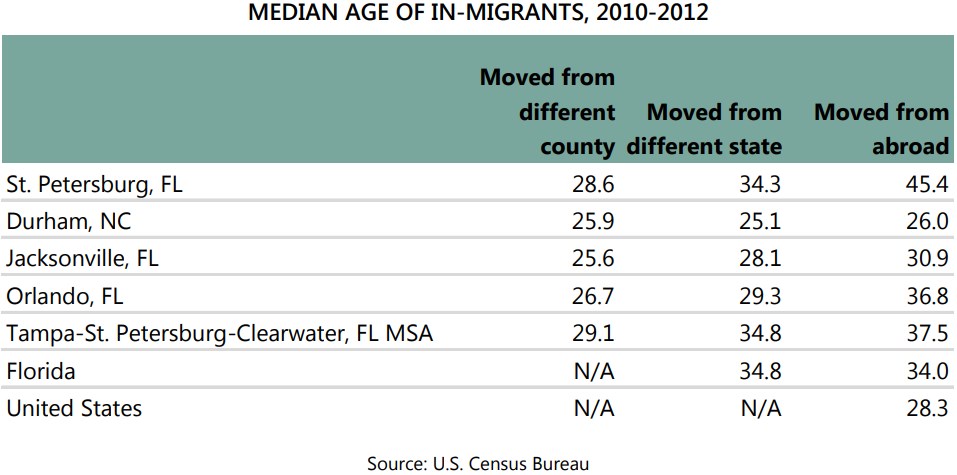
More notable is the median age of international migrants to St. Petersburg. Data are not available to determine the degree attainment of this specific group of in-migrants, but it is possible that they are drawn to the area’s mix of lifestyle amenities and expanding professional opportunities.
Data covering all in-migrants to the city is available, and in a very positive sign for St. Petersburg’s workforce capacity, in-migrants have higher cumulative bachelor’s degree-plus attainment than all the comparison areas except for the knowledge hub of Durham, North Carolina.
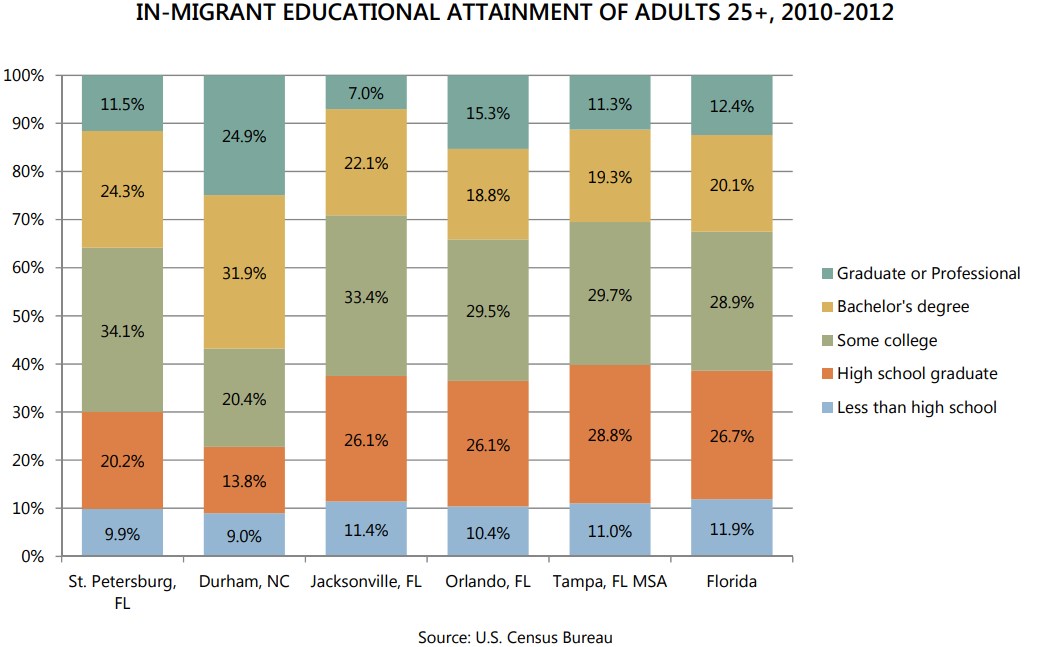
In-migrants are also slightly more diverse than the St. Petersburg average; 39.7 percent of migrants from 2010 to 2012 were minority, compared to 38.2 percent city-wide.
While detailed migration data are not available at the city level, a deeper look into Pinellas County’s foreign-born population demographics reveals that the county’s international residents are largely from Latin America (31.5 percent of all foreign-born residents of Pinellas County), Europe (31.0 percent), and Asia (23.5 percent). This is a greater level of diversity among international residents than in the Tampa MSA and the state of Florida. In Tampa, over half (53.2 percent) of its international residents are from Latin America, while in Florida three quarters are from Latin American countries.
Compared to the average resident in Pinellas, foreign-born residents are older, have a lower median household income, are slightly more likely to live in poverty, and have larger households. Foreign-born residents, as a group, are just as likely as all Pinellas County residents to hold at least a bachelor’s degree. When origins are taken into account, each subgroup has distinct characteristics. Residents who are originally from Latin America are younger but are less likely to have a four-year degree or higher, have lower median household incomes, and have higher levels of poverty. Residents originally from Europe are much older, have household sizes closer to the average countywide household size, and have the lowest poverty rate of the groups examined. Foreign-born residents from Asia have high levels of bachelor’s and graduate degree attainment, have comparatively high median household incomes, are younger than the average county resident, and also have the largest households.
Data from the Internal Revenue Service is consistent with Census data but provide more insight into recent migration patterns. Between 2006 and 2011, foreign in-migrants on average have lower household incomes ($34,385) than foreign out-migrants ($50,550). However, this is due to a large amount of highincome residents moving to another country between 2010 and 2011. In this year, the average household income of foreign out-migrants was $119,531. In other years, that figure was much lower and nearly equivalent to the incomes of foreign in-migrants. Additionally, international in-migrants during the fiveyear span had household incomes $10,000 lower than domestic in-migrants. Interestingly, household incomes of all migrants, domestic and international, were lower on average than incomes of existing residents.
An important consideration in any discussion of migration is the degree to which a community is “welcoming” of newcomers and provides access to established social and business networks. St. Petersburg’s residents, recent and long-term, overwhelmingly assert that the community is a welcoming place. Many public input respondents commented on the “Midwestern values” that continue to pervade St. Petersburg, with a strong community ethic and neighbor-helping-neighbor mentality. One interviewee recalled their first years in the city and the openness of existing residents to new professional relationships. The newcomer was “blown away by the sense of community” in St. Petersburg and noted that they were able to “make a mark” in a way inconceivable in a larger community like Chicago or New York City. “As an outsider, I was still welcomed with open arms,” they said, noting that St. Petersburg was even more open to newcomers than Tampa, where the “good old boy network is more prevalent.”
RACE AND ETHNICITY
During the last decade, St. Petersburg has also diversified in terms of racial and ethnic backgrounds, consistent with national trends. From 2007 to 2012, the city experienced a 1.4 percent decline in nonHispanic whites, compared to a 0.7 percent decline nationwide. The growth in St. Petersburg’s Hispanic population was substantial—9,793 Hispanic residents were added over the five year period, or 89.5 percent growth; this represented the greatest nominal and percentage increase across all racial and ethnic groups in the city and increase eclipsed all other comparison geographies. One interesting divergence in St. Petersburg from the comparison geographies was its decline in Asian population during this period.
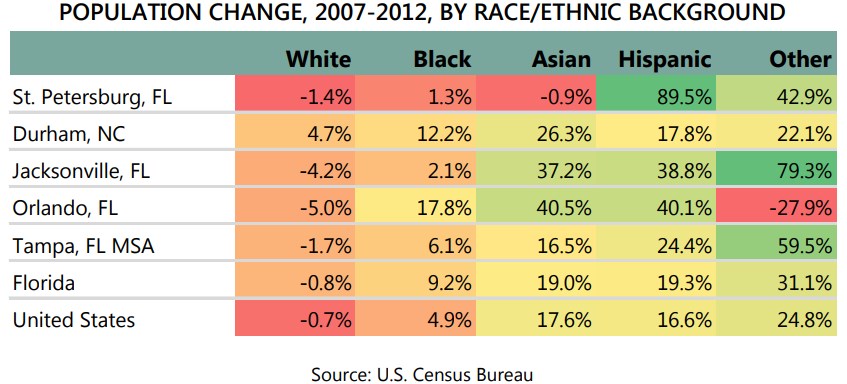
As the following chart shows, St. Petersburg, while more diverse than the Tampa metro and Pinellas County, is still significantly less diverse than its comparison cities, the state, and the nation. As the city continues to diversify, it will become increasingly important that the composition of local elected, appointed, and private leadership reflects the changing demographics of the city itself.
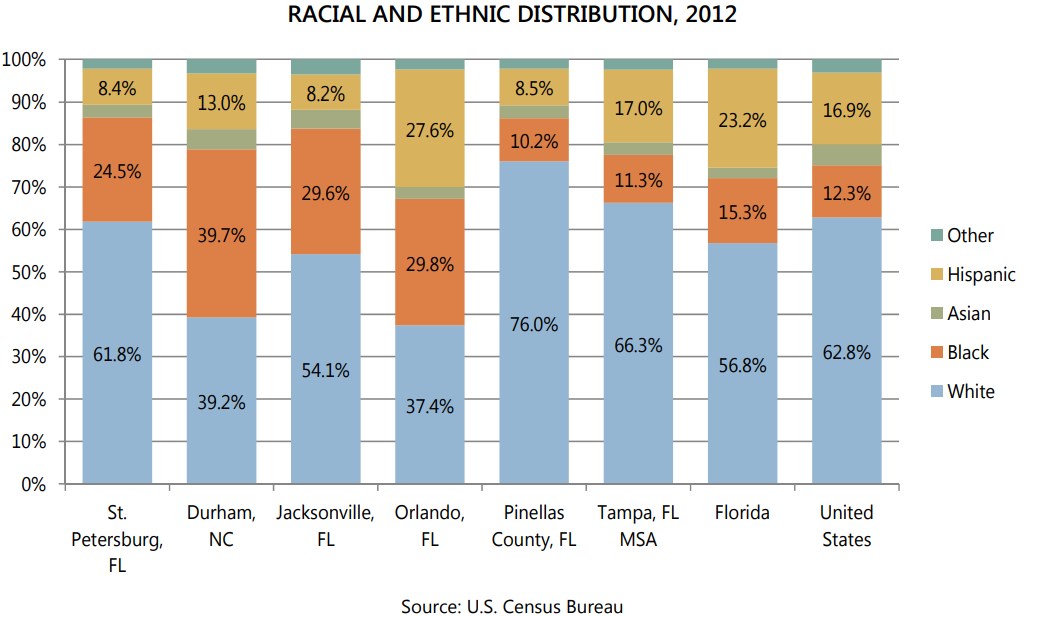
Despite positive feedback about St. Petersburg’s history of welcoming of newcomers, stakeholders believe that the city still must work to be more inclusive. One input participant said, “This community has never been comfortable talking about race.” Central Avenue has traditionally been the “dividing” line between black and white St. Petersburg and, despite progress in recent years, residents say some of these long-standing divisions still hold. One respondent said that some officials are “scared” at times to give feedback to minority leaders for fear of being seen as antagonistic, adding that, “We need facilitators – bridge builders.” Others said that there is still not a great deal of diversity in leadership in St. Petersburg, which leads to the perception among some outsiders that the city is “still old and white.” However, the city is changing in other ways. For example, St. Petersburg has the largest gay pride festival in the state; many credit the gay population with spurring the revitalization of the Grand Central district and other arts hubs.
When asked to rate statements on the community’s diversity and openness, on a scale from 1 (strongly disagree) to 5 (strongly agree), survey respondents collectively rated the statement “St. Petersburg is a welcoming place” as 3.99. When cross-tabbed by race, the average rating of nonwhite residents was 3.75, compared to 4.02 by non-Hispanic whites. “Opportunities, communities, and networks in St. Petersburg are accessible and open to a diverse range of people” received a much lower ranking of 3.53 overall, with whites rating this statement 3.58, and non-whites, 3.2. Residents noted the “Central Avenue invisible color line” as a persisting issue and that “more could be done to integrate and involve low income minority populations.” Another said that “the 2020 plan is a good start,” and one suggested that St. Petersburg “keep building on the inter-cultural exchanges that already exists. Keep celebrating our diverse communities more and more.”
INCOME AND POVERTY
Ultimately, economic development is about creating quality jobs that serve to raise the income levels of all local residents. As such, it is important to examine the well-being of the population and how it has changed over time. As seen in the following table, changing age and racial/ethnic demographics have not had an adverse effect on St. Petersburg’s household incomes. The city’s median household income of $45,119 trailed only Durham and the U.S. among the comparison geographies. Additionally, St. Petersburg’s growth rate of 7.4 percent trailed only Durham among the comparisons. When seen in the context of the Florida geographies, St. Petersburg’s performance is even more notable. Jacksonville households saw a 12.1 percent decline in income, with Orlando and the state also experiencing losses.
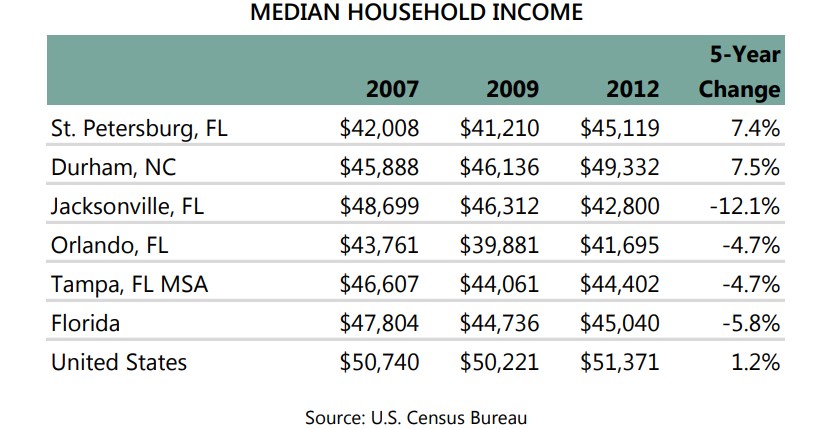
When race and ethnicity are factored in, data show that St. Petersburg’s Hispanic households are doing well, with a median income of $40,814, roughly $3,000 higher than the state average. The income gap between Hispanic and white households is smaller in Pinellas than both Florida and the U.S. However, not all races and ethnicities in Pinellas are experiencing these trends. The black-white median household income gap in the county is $19,306, larger than the state of Florida ($18,182).
As seen in the following chart, rising incomes in St. Petersburg have kept adult and youth poverty rates below most of its comparison areas.
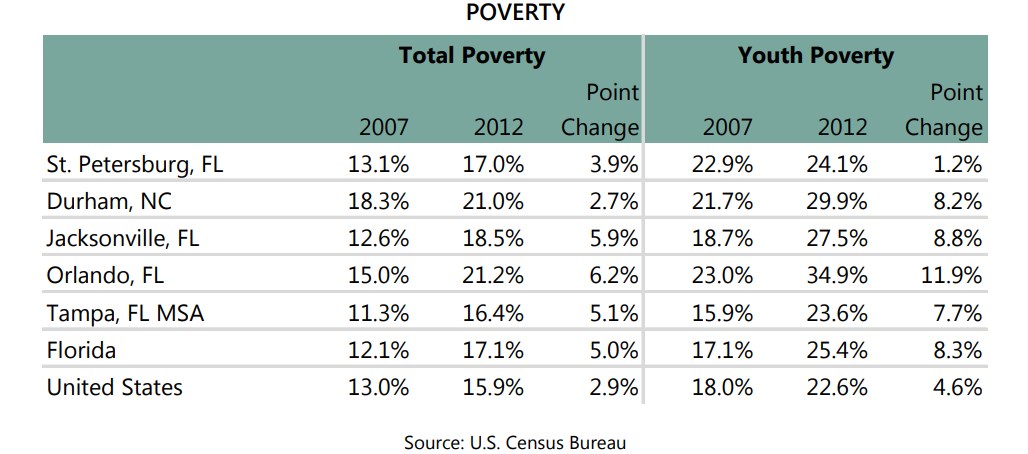
In 2013, the federal poverty threshold for a family of four with two children was $23,624. In St. Petersburg, 17 percent of households are in poverty, on par with the state of Florida and slightly higher than in the metro (16.4 percent) and the nation (15.9 percent). The city’s youth poverty rate (24.1 percent) has similar comparative dynamics. Despite the elevation compared to the metro and nation, St. Petersburg residents are doing well compared to its comparison cities. The city has a much lower percentage of families and youth in poverty than its peers, and its overall poverty rate has increased over a five-year period at a slower pace than Florida comparisons, partially due to St. Petersburg’s relatively small household size. There was a marginal increase in the city’s youth poverty rate from 2007 to 2012, much less than that of all comparison geographies.
In order to shed more light on poverty dynamics in St. Petersburg and Pinellas County, the County Board of Commissioners published the Economic Impact of Poverty report in 2012. A particular area of focus was South St. Petersburg, which has a poverty rate of 25 percent. The report highlights one particular Census tract in that area (245.03) that has a poverty rate of 48 percent, the second highest in Pinellas County. Overall, the report found that poverty in five high-poverty districts costs taxpayers $2.3 billion per year. A 2013 update report increased that total to $2.8 billion, while subsequent research estimated poverty costs for South St. Petersburg alone at $660 million per year.
Designed to reverse these trends, the 2020 Plan is a five-year $170 million initiative to reduce the poverty rate by 30 percent in South St. Petersburg by the 2020 Census. Set to launch in 2014, the Plan emerged from discussions and efforts from community leaders who later enlisted the support of Pinellas County and the city of St. Petersburg. In 2012, the city formalized a link between the 2020 Plan and the Southside Community Redevelopment Area (CRA) investment zone. The Southside CRA is poised to become the first new TIF district in St. Petersburg since 1992. Leaders of the 2020 effort see the CRA as a core building block of their poverty-reduction strategy. In March 2014, the Florida House and Senate appropriated $1.6 million for the 2020 Plan in the state’s next budget. However, in June 2014, Governor Rick Scott vetoed the budget recommendation despite the bipartisan support it garnered. The 2020 Task Force plans to move forward with its plan, leveraging federal funding, private foundation grants, local public funding, and private investments.
Public input participants identified generational poverty in St. Petersburg as one of the city’s most challenging issues. In many ways, one focus group participant said, “St. Pete is a tale of two cities,” with downtown and a handful of intown neighborhoods thriving and many others still struggling. The impacts of poverty were linked to challenges faced by Pinellas County schools, persistently high crime rates, poor local health outcomes in selected populations, and “food deserts” across many low-income neighborhoods.
Opinions varied on the portrayal of high-poverty neighborhoods in the local media. While some feel that progress in these districts has not been reported, others said that the magnitude of St. Petersburg’s generational poverty issue has actually been under-reported.
Poverty has also contributed to growth in St. Petersburg’s homeless population. In 2010, a Strategic Action Plan to Reduce Homelessness for Pinellas County was developed with recommendations that included, among many, coordinating and streamlining existing organizations in terms of decision-making, funding, and service delivery; improving services for families with children; and upgrading Pinellas Safe Harbor and
Pinellas Hope. Pinellas Safe Harbor is a homeless shelter designed to serve as an alternative to jail. The city of St. Petersburg has also invested much recent time, effort, and resources towards revitalization of disinvested neighborhoods, including helping to form resident and business associations, developing neighborhood plans, incentivizing the development of new retail like the January 2012 opening of a new Walmart Neighborhood Market in Midtown, and funding streetscape improvements in key corridors.
Positives
- Despite flat population change, poverty has experienced relatively slow growth during the period (2007-2012) that coincides with the Great Recession and subsequent sluggish recovery. At the same time, incomes are rising at a comparatively rapid rate. St. Petersburg also has a lower percentage of families and youth in poverty than its comparison cities.
- St. Petersburg has attracted diverse and well-educated new residents. In-migrants have higher cumulative bachelor’s degree-plus attainment than all the comparison areas except Durham, NC.
- The city is attractive to young professionals without children, as evidenced by smaller than average household sizes, low birth rates, and age distribution dynamics.
- Although overall population growth is flat due to natural change, the city of St. Petersburg enjoys a high level of international net in-migration.
- St. Petersburg is a relatively wealthy community. The city’s median household income was higher than all comparison geographies except Durham and the U.S. Incomes have grown more rapidly in the city than in its comparison geographies.
- The median Hispanic household in St. Petersburg earns more than their national counterparts. The income gap between Hispanics and white is much smaller in St. Petersburg than the state and nation.
- Residents provided resounding feedback that the city has a welcoming atmosphere, important for a place experiencing rapid diversification and high levels of in-migration.
Negatives
- The city of St. Petersburg and Pinellas County have both experienced population loss since the 1970s and are currently approaching 2000 levels. This is fueled by negative natural change, which has erased positive migration trends.
- With low birth rates, the city and county are not producing a growing number of residents who have lifelong connections to the community
- Although the average domestic in-migrant is significantly younger than the average existing resident, St. Petersburg’s in-migrants are much older than those moving to comparison cities.
- Although St. Petersburg is aging at roughly the same pace as the average American community, its average age is well above that in comparison communities, which has important implications for a broad array of issues including workforce, health and social services, and government revenues.
- Data regarding age dynamics of the community implies that St. Petersburg is not as attractive to families with children as its counterparts are, possibly reflecting the lack of confidence in public schools.
- While the city continues to diversify, its image has not kept up with reality. Although residents feel St. Petersburg is a welcoming place, they don’t feel it is as inclusive as it could be.
Returning to Residential Growth: Attractiveness to Existing and New Residents
As discussed in the previous section, while St. Petersburg’s total population has been stagnant since the 1970s, the composition of its population continues to change and diversify. This section will discuss a few of the key factors that have impacted and will continue to impact the community’s appeal to existing and prospective residents. In addition to economic conditions discussed in subsequent sections, the ability of the community to promote residential growth will depend heavily upon the community’s promotion and development of certain assets while addressing challenges that serve as residential disincentives.
Assets
The following elements comprise key assets that contribute to the attractiveness of St. Petersburg as a residential destination. The below graphic represents a “word picture” of the most commonly used terms when community survey participants were asked, “What is St. Petersburg’s greatest strength?” Downtown St. Petersburg and the waterfront are by far considered as the city’s greatest assets, with arts also a key amenity.

Downtown St. Petersburg
As was referenced in the previous section, some St. Petersburg stakeholders view the city as “Downtown and everything else.” In only a few short years, Downtown St. Petersburg has become a thriving hub of retail, residential, entertainment, and recreation amenities and is slowly becoming the crux of the community’s entrepreneurial ecosystem. A potential innovation corridor of healthcare and marine sciences is poised for growth and cranes dot the skyline as new high-rise residential towers come out of the ground to meet growing demand for a “live, work, play” downtown environment.
The waterfront has always been seen as St. Petersburg’s greatest physical asset, serving as an anchor for industrial development in the late 1800s and early 1900s and then as the focus of the city’s beautification efforts in the 1910s and 1920s.2 The waterfront is now the location for many of the assets that makes St. Petersburg’s downtown a hotbed for growth and development: Albert Whitted Airport, the Port of St. Petersburg, plush greenspace for residents and visitors, marinas and aquariums, museums, arts amenities, University of South Florida St. Petersburg, All Children’s Hospital, Bayfront Family Health Center, St. Anthony’s Hospital, and private research firms such as SRI International.
By city charter, the bayfront cannot be developed, but the Downtown Waterfront Master Plan, currently under development, is expected to recommend planning options for sites such as Al Lang Stadium, a home for baseball spring training and international baseball, and Whitted Airport. While potentially divisive, the Plan is also anticipated to include potential re-use scenarios for the St. Petersburg Pier, the redevelopment of which has been a long-standing issue for local residents. A referendum for a new signature Pier structure was resoundingly defeated by city voters.
The St. Petersburg City Council is currently debating the merits of contracting with the planning firm AECOM for up to $500,000 to develop the Waterfront Master Plan and the planning geography that will be utilized for the analysis. The Council is slated to make its final decision on May 15, 2014. Council members would also like to see the results of an earlier development study by the Urban Land Institute incorporated into the Master Plan. The city is required to complete the Master Plan by July 2015, the result of a voterapproved referendum. The specific functionality and design of the St. Petersburg Pier will not be addressed in this master plan, however the Pier plan and the waterfront plan will be integrated and the issue is being advanced by Mayor Rick Kriseman.
Scheduled to open in spring 2014, The Sundial, a project by local businessman Bill Edwards, is a completely refurbished transformation of the former BayWalk retail/entertainment complex. Edwards has invested $40 million in the upscale shopping center with planned tenants that include Ruth’s Chris Steak House, Diamonds Direct, and White House Black Market.
One stakeholder called the revitalization of Downtown St. Petersburg, “A 25-year overnight success story.” Key catalysts included the construction of BayWalk, the redevelopment of the Vinoy Hotel and resort, and the launch of the Grand Prix of St. Petersburg. Subsequent investments in health care facilities, marine research institutions, and the University of South Florida St. Petersburg’s (USFSP) ongoing commitment to downtown were also major factors in the district’s revival. Now, leaders feel that additional meeting space, more Class-A office capacity, and business incubation facilities will help further downtown’s development into an even more dynamic mixed-use destination.
Lack of parking was also noted by input participants as a key issue. However, some acknowledge that ample parking exists but that it needs to be better promoted or connected via a wayfinding system.
Finally, while stakeholders showed excitement and support for the improvements happening in downtown, many expressed the desire to see similarly aggressive attention paid to districts outside the city center.
Another flashpoint for downtown discussion and controversy is the future of the Tampa Bay Rays in St. Petersburg. Though they have a use agreement to play at Tropicana Field until 2027, the team has expressed the desire to relocate to a new stadium either in the city or across the bay in Tampa. Even those who support the Rays remaining in St. Petersburg say that the opportunities to develop the 86-acre Tropicana Field site are enticing, especially because it abuts the assets of a potential innovation corridor. With St. Petersburg’s and the TDC’s debt obligations fulfilled at Tropicana Field in two years, interest groups are positioning themselves to claim the tourism dollars that will be freed up for other uses.
Arts and Culture
Known as the “City of the Arts,” St. Petersburg has a long history of supporting arts and culture as a key component of its tourism-development strategies. The city was the site of the first art gallery south of Atlanta and was the first Florida city to organize its museums. Currently, St. Petersburg is known for its concentration of blown-glass artists and benefits from the presence of dozens of top-ranked galleries, several theatrical and music venues, many world-famous museums, seven performing arts companies, and over 1,000 public events annually. Five distinct arts districts are located in the city, including Grand Central and the Warehouse Arts District. In 2013, ArtPlace America named Downtown St. Petersburg one of America’s top ArtPlaces. For three years running, American Style Magazine has named St. Petersburg as its number one mid-size city for art. The New York Times included the city on a list of 52 global places to go in 2014, while British newspaper The Independent reported that St. Petersburg now rivals Miami as an arts destination.
As the following table shows, non-profit Pinellas County arts organizations are numerous and receive comparatively high levels of support from philanthropists. Only Durham and the U.S. had higher per capita numbers of arts organizations and revenue per resident.

Stakeholders in the arts community expressed concern in public input that St. Petersburg’s competitive advantage in the arts is at risk due to a lack of public and private support. One participant noted that everyone in the arts world is “hanging on by the fingernails. We need businesses to step up and support us.” Another added, “The city is building its reputation on the back of artists,” but the sector is not being funded. According to arts officials, six local galleries have moved to other cities in the last four to five months. Ultimately, said one stakeholder, “artists need more arts buyers, and that comes from promotion.”
Another obstacle, according to input participants, is St. Petersburg’s “complicated minefield of little arts groups” that makes it hard to organize and focus the constituent base.
Recently, the Tampa Tribune reported that a newly formed alliance of arts organizations called the PinArts Coalition is demanding that Pinellas County restore funding that was cut during the recession. At one point, the now defunct Pinellas County Cultural Affairs Council provided $600,000 in annual grants to local arts organizations, while the Tourist Development Council (TDC) delivered $750,000 in bed tax dollars each year. PinArts would like to see $1.5 million in county and TDC money dedicated to arts and culture and the creation of a $150,000 “artist resource fund.” It is also calling for the City of St. Petersburg to return the amount available for arts grants to prerecession levels. City funding for local arts grants fell from $400,000 to $175,000 in 2008 and has not been increased.
Walkability
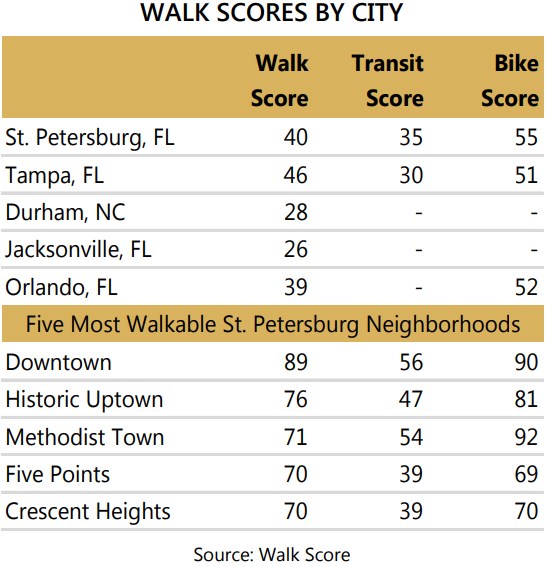 Communities are beginning to understand that
walkability is a multi-generational desire. Walkable places
feature destinations like grocery stores, restaurants,
entertainment, retail, green space, and other amenities
that can be accessed by foot on one trip. Research has
shown that the Millennial generation is partial to
communities with options beyond cars for getting
around and that some actively seek places to live that
provide ample alternatives to driving, such as public
transportation, ride sharing, and car sharing. Also
applicable is the growing research showing that seniors
value walkability in communities to help them maintain a
healthy, active lifestyle and access to services beyond
their driving days. More and more people, irrespective of
age, enjoy easy access to “third places”—a place they can
go for social interaction outside of home and work.
Communities are beginning to understand that
walkability is a multi-generational desire. Walkable places
feature destinations like grocery stores, restaurants,
entertainment, retail, green space, and other amenities
that can be accessed by foot on one trip. Research has
shown that the Millennial generation is partial to
communities with options beyond cars for getting
around and that some actively seek places to live that
provide ample alternatives to driving, such as public
transportation, ride sharing, and car sharing. Also
applicable is the growing research showing that seniors
value walkability in communities to help them maintain a
healthy, active lifestyle and access to services beyond
their driving days. More and more people, irrespective of
age, enjoy easy access to “third places”—a place they can
go for social interaction outside of home and work.
The table above shows that the Tampa Bay area has a competitive advantage in terms of walkability compared to the other cities profiled in this report. Downtown and Historic Uptown St. Petersburg are especially competitive in this regard. Although St. Petersburg’s bike score is higher than Orlando and Tampa, the score is relatively low on a national comparison. The City Trails program is approximately 10 years old and has been improving the city’s bike score. , St. Petersburg’s relatively low scores on transit and biking capacity show that there is much work to be done to enable true multi-modal mobility in the city.
Even though Shermans Travel named St. Petersburg one of its top ten cities for cycling because of its 35 miles of bike trails, 75 miles of on-street bike lanes, and status as a bronze-level Bicycle Friendly City by the League of American Bicyclists since 2006, stakeholders would like to see enhanced bike lanes and trails, including wider lanes and more off-street biking infrastructure.
A key initiative that would potentially increase St. Petersburg’s transit score is Greenlight Pinellas, a mass transit referendum scheduled for a public vote in fall 2014. The Greenlight Pinellas Plan includes bus improvements and future passenger rail that supporters say would significantly enhance public transportation in Pinellas County. The plan would be funded by a proposed 1 percent sales tax increase and would be implemented over span of 30 years. Components of the plan include:
- A 65 percent increase in overall bus service throughout Pinellas County
- Bus Rapid Transit lines on most major Pinellas corridors.
- Buses running to and from Tampa and the airport in the evenings and on weekends
- Longer service hours to accommodate second shift workers and evening travelers
- Light Rail – 24 miles
- Future passenger rail from St. Petersburg to Clearwater via the Gateway/Carillon area
Multiple public and private officials speaking in public input identified Greenlight Pinellas as a potential “game changer” for St. Petersburg. In addition to improving rail and bus transit capacity and connectivity, the opportunities for transit-oriented development (TOD) and the creation of activity and job centers around stations could be transformative for the city and complement its already high density and walkability. Though the initiative is supported almost unanimously by business and civic associations on both sides of the Bay, officials fear that perceived burdens caused by increased sales taxes could sway public opinion against the measure. Current polls show that a majority of likely voters support Greenlight Pinellas.
The following pages comprise key challenges to raising St. Petersburg’s population levels as identified by research and public input. The below graphic represents the terms most used by community survey respondents when asked about St. Petersburg’s “greatest threat or challenge” to overcome. Crime, homelessness, transportation, the Pier, and housing were among the top challenges identified. Downtown, a top asset, was also a top challenge, likely because of public safety and homelessness issues.
CHALLENGES
The following pages comprise key challenges to raising St. Petersburg’s population levels as identified by research and public input. The below graphic represents the terms most used by community survey respondents when asked about St. Petersburg’s “greatest threat or challenge” to overcome. Crime, homelessness, transportation, the Pier, and housing were among the top challenges identified. Downtown, a top asset, was also a top challenge, likely because of public safety and homelessness issues.
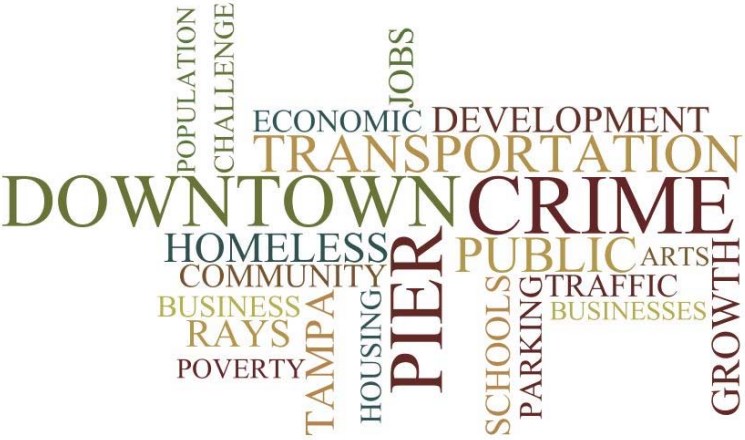
Land Capacity
Though it is a misnomer that St. Petersburg is “built out,” as many people allege, it is true that there are few if any major “greenfield” sites available for development, either residential, retail, office, or industrial. This notion is validated by the data in the following table showing the comparative densities of St. Petersburg and the benchmarks. While the comparison areas have become denser in recent years, St. Petersburg is still by far the densest of these geographies. The city has nearly 4,000 people per square mile and has likely not shown the increases in density of the comparison areas because of factors possibly including residential abandonment due to the foreclosure crisis, limited redevelopment and high-rise infill construction due to the effects of the Great Recession, and the plain fact that there is not a lot of land for new construction.
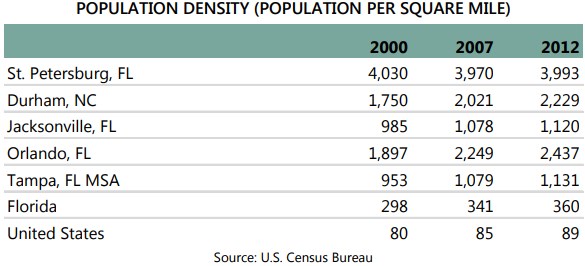
With seven CRAs, three with available TIF, and other tools, Pinellas County and the city of St. Petersburg feature a number of programs supporting neighborhood revitalization, redevelopment and infill construction.
Public officials say that the city and county are still coming to grips with the “new normal” of postrecession Pinellas. Governments are looking at opportunities for regeneration and adjusting landuse and zoning controls accordingly. Future land-use plans are being reexamined not only in the context of redevelopment but also to capture potential opportunities related to Greenlight Pinellas passage and the continuing spread of development pressures outward from Downtown St. Petersburg into the downtown’s close-in neighborhoods.
Housing
As was noted, along with perception of school quality, the top issue constraining St. Petersburg’s future growth identified by stakeholders is the quality of the city’s housing stock. There are over 1,000 condo and apartment units currently under construction in Downtown St. Petersburg, with plans for an array of price points, to accommodate the demand for housing in the thriving area. However, the need for detached homes, both to purchase and to rent, with enough square footage, bedrooms, and bathrooms to satisfy growing families is a pressing concern for city officials, and is consistent with the earlier finding that St. Petersburg is not currently attracting young families with children. The city’s historic attractiveness as a retirement destination led to the construction of thousands of “2+1” concrete block homes-on-slab sufficient for the needs of middle-income retirees but inadequate for the demands of modern couples and families. More condos and apartments reinforce current dynamics, and housing diversification is necessary if St. Petersburg wants to increase its attractiveness to families. Because of the lack of land capacity, building new detached homes is not a viable solution—revitalization and renovation of existing homes will be key.
Young professionals and entrepreneurs commented on the unavailability of nice, affordable housing in St. Petersburg, stating that newer homes in favorable neighborhoods are unattainable pricewise and that affordable homes were either located in neighborhoods they are uncomfortable moving to or needed too much rehabilitation work.
The Venture House project seeks to address this deficit and revitalize neighborhoods at the same time by leveraging a combination of private and public funds and “sweat equity” to transform dilapidated homes into residences that can attract entrepreneurial and artistic talent from the region and elsewhere into St. Petersburg’s core. Venture House is spearheaded by Frank Wells, who uses a community land trust model to hold properties and connect buyers with resources to purchase and rehab the homes.
The quantity of available homes in St. Petersburg increased after the recession as more residents in the city turned to rental housing from 2007 to 2012. While consistent with trends across the state and country, St. Petersburg experienced a larger percentage decline in home-ownership than all the comparison areas, from 66.0 to 57.6 percent.
In addition to challenges homebuyers face due to tightening credit markets, another major issue affecting whether individuals can retain or purchase homes is the dramatic increase in flood-insurance premiums. When the Biggert-Waters Flood Insurance Reform Act took effect on October 1, 2013, homeowners saw insurance rates increase by 20 percent per year or more. Partial relief is on the way as a new federal bill, known as the Homeowner Flood Insurance Affordability Act, recently signed into law keeps rates from climbing more than 15 percent annually and institutes a hard cap of 18 percent. The bill goes into effect on May 1, 2014, and homeowners should see the new rates reflected in their insurance premiums when they renew their policies. While primary homeowners will likely see benefits, businesses and second-home buyers will not see significant reductions in their insurance bills.
Public Safety
Public safety is a critical component of a community’s quality of life. Dynamics of crime typically involve two elements: the reality of crime and the perception of crime. Each is important because perception is the equivalent of reality for most residents and businesses. Data reveals that crime is on the decline in St. Petersburg. However, crime is very high in the city and considerably higher than the metro average. Despite this, the Tampa Bay metropolitan statistical area (MSA) has relatively low crime as compared to other Florida metros.
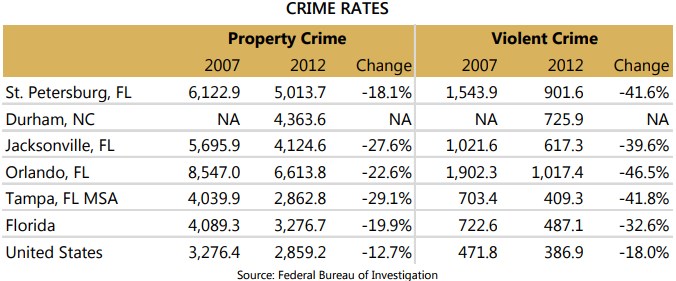
In a very positive sign, violent crime in St. Petersburg has decreased over time at a rate on par with the metro and at a higher pace than the state and nation. It is also important to note that while Orlando experienced a higher percent decrease in violent crime, its 2012 rate is still the highest among all geographies. Unlike violent crime rates, property crime in St. Petersburg has not declined at a competitive rate; its improvement lags behind comparison cities, the metro, and the state. As St. Petersburg attempts to reverse its population outflows, persistent issues of crime are a significant barrier to attracting and retaining households, especially families with children.
Survey respondents were asked to name St. Petersburg’s greatest threat or challenge to overcome. Among the top answers was crime. When asked “If you will not continue to live in the community, and/or feel your children will not choose to live in the community, why do you feel this way?” one respondent answered “I am not sure it is a safe place to raise children.” Sense of personal and property safety was among the lowest rated quality of life aspects, garnering an average response of 3.2 of 5 total points.
Public Education
One significant challenge to St. Petersburg’s quality of life is the perceived quality of Pinellas County public schools. As noted in the previous storyline, public education was said to be a major deterrent to residing in St. Petersburg for young families with children or who plan to have children.
On the face of the issue, Pinellas County performance measures such as SAT and ACT scores are roughly equivalent to the Florida state average, while graduation rates are just slightly lower. Compared to the districts of comparison communities, Pinellas County has low four-year cohort graduation rates, though ACT scores are higher than in Florida peer counties and SAT scores are higher than two of three comparisons. Coupled with lower child poverty and “teenage idleness” rates than the comparison areas, a lower percentage of Pinellas students are eligible for free or reduced-price lunch – considered a proxy for determining low-income student totals for comparisons across states. In fact, when compared to districts in the comparison communities, only Duval County, Florida has a lower percentage of free and reduced-price eligible students. These common measures of exposure to “at-risk” conditions do not seem in line with public perception that Pinellas County Schools are an option of “last resort” for many families.
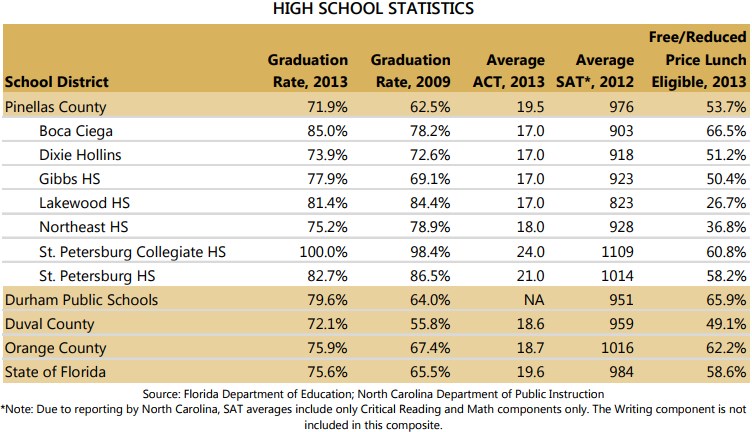
When the high schools in St. Petersburg are examined, data continues to contradict the perception that the city’s schools are challenged. Only three of the seven high schools in St. Petersburg have a greater proportion of students eligible for free or reduced price lunch than the county average. Although college readiness exam scores are on average lower in St. Petersburg high schools than the county, graduation rates for all high schools in the city surpass the county average. This fact is counter to the feedback of many who said the Pinellas schools outside St. Petersburg perform better. Additionally, when Florida Comprehensive Assessment Test (FCAT) scores are taken into account, there are clear stars in St. Petersburg’s public district. Consistent with higher standardized college entrance exam scores, St. Petersburg Collegiate High School and St. Petersburg High School have higher percentages across all subjects of students scoring satisfactory or higher on the FCAT. This is generally true for students at these schools by racial group and for students who are considered economically disadvantaged as well. Gibbs students are strong in Writing and Science, but weak in Math and Reading with economically disadvantaged students trailing school averages by 11 percent and 10 percent, respectively. While the remaining schools do have bright spots in varying subjects, five of the seven high schools in the city have low percentages of students performing well in Reading.
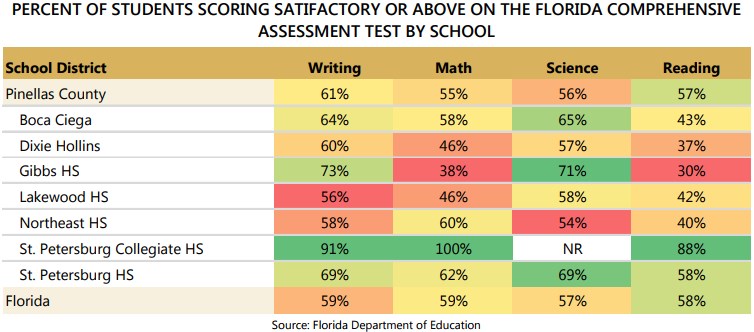
In 2013, the Pinellas County district was graded a C by the Florida Department of Education, which is based on a number of factors including reading, mathematics, science, and writing assessment scores and improvements from previous years. Only one high school in the district scored less than an A or B, and that school was not located in St. Petersburg. Boca Ciega, Lakewood, St. Petersburg High, and St. Petersburg Collegiate High are among the Pinellas high schools earning As. However, this is a new achievement; from 2012 to 2013, schools earning C scores were upgraded to Bs. In 2010, two St. Pete high schools earned Ds. As the school district continues to make valuable changes that result in better performance results, these accomplishments will need to be promoted in order to avoid persistent negative perceptions of improvement trends that may not be entirely valid.
More insight is gleaned in elementary and middle schools. Of the elementary schools located in the city, 11 earned A or B, 7 earned a C, and 8 earned D or F. Unfortunately, many of the low scoring middle schools are located in St. Petersburg. Of the seven middle schools in the city, only one, Thurgood Marshall Fundamental School, scored an A. Two earned Cs, and the rest earned D or F. It is important to note, though, that there are many other elementary and middle schools outside of the city of St. Petersburg that have earned low scores. Nevertheless, parents may choose communities outside the city of St. Petersburg in these grades if these trends continue.
While it is evident that St. Petersburg schools have challenges in some areas, the data does not support the notion that St. Petersburg schools are not competitive with the rest of the district, and parents do have access to a wide range of school models. Alternative campuses include magnet programs, career academies, and fundamental schools. There are also independent schools, charter schools, and traditional private and parochial schools in the city. The curricula and structure of these schools vary.
Additionally, the business community has close ties with the district. Through a partnership with Ford Next Generation Learning and the Florida Association of Career and Technical Educators, the school district has begun implementation of its Academies of Pinellas Five Year Master Plan, which has resulted in a career academy at every high school in Pinellas County guided by industry specific advisory councils. The career sectors represented in St. Pete high schools include finance, information technology, automotive, and graphic arts. Lakewood High School has a marine sciences program in its Academy for Aquatic Management Systems and Environmental Technology.
The Pinellas district also has a mentoring program for students called Executive P.A.S.S. (Partnership to Advance Student Success), involving several area businesses such as Raymond James, through which CEOs along with their employees assist with mentoring students and providing administrators with business perspectives. As the district continues to make strides in providing quality educational opportunities for Pinellas County students and realize subsequent improvements in performance measures, it will need to ensure that residents know about these advancements and that they are happening districtwide, including in St. Petersburg.
Multiple stakeholders indicated that newcomers to the region with school-age children are encouraged to choose Tampa over St. Petersburg because of the difference in quality of schools. Also per stakeholder input, Pinellas County Schools is not the preferred choice for parents in St. Petersburg, unless they are able to win the lottery for the district’s fundamental schools. When commenting on alternative Pinellas campuses, one input respondent said that lower income students are “left behind in regular school.” Participants said there is a “clear border” that divides north and south Pinellas County in terms of perception of school quality with north county schools considered strong and south county’s seen as poor.
Focus group participants added that community and parental involvement is often lacking in Pinellas schools, as are effective mentoring programs for students. Some said that a lack of resources and “lack of will” to make significant changes in the district are also challenges.
Survey respondents were asked to rate various statements about public school quality. “Children in our district receive a high-quality education” received the lowest rating, with a score 2.69 of 5 total points. Career guidance and hands-on work experiences received a rating of 2.93, while the commitment of community and business leaders received 3.03. Among the higher rated (yet still low) statements were opportunities for parental involvement (3.88), available and affordable pre-K programs (3.46), and committed and engaged teachers (3.46).
Positives
- Rapid transformation of Downtown St. Petersburg in recent years is a point of pride for the community. Its “live, work, play” environment has attracted many new residents, while there are several opportunities for business expansion, attraction, and innovation within the corridor.
- St. Petersburg’s vibrant arts community includes world-renowned attractions and has been featured in major publications for its assets. Pinellas County has numerous non-profit arts organizations which receive competitive levels of support from philanthropists.
- St. Petersburg’s walkability is attractive to both the young workers it needs to develop a sustainable workforce and the older retirees who will become decreasingly reliant on cars over their lifetimes.
- Greenlight Pinellas promises to be a game changer for the community if passed this year. There are several enhancements within the plan that will address the connectivity needs that stakeholders have expressed.
- Pinellas County and the city of St. Petersburg feature a number of tools and programs supporting neighborhood revitalization, redevelopment and infill construction.
- Although public perception of schools is mixed, the Pinellas County school district and St. Petersburg campuses have competitive bright spots and are making strides in improving performance results and creating and maintaining meaningful relationships with businesses in the community.
Negatives
- Although the city has seen major declines in recent years, St. Petersburg still has high crime rates and issues of homelessness, which can be residential deterrents to both existing residents and potential new residents
- Lack of business support, lack of government funding, and disconnected arts organizations are among the issues that the arts community has identified as threats.
- Although downtown St. Petersburg will soon have over 1,000 rental and condo units available, the city has single-family detached housing stock that needs to be revitalized to help the city attract families, especially as limited land is available for new construction.
- Public schools are not the preferred option for parents in St. Petersburg and suffer from key perception issues. Residents do not seem to be aware of the improvements that are happening in the public system.
A Stalled but Evolving Economy
Similar to St. Petersburg’s population decline, the city’s economic fortunes in the past decade have not been laudable. Though home to major corporations, large hospitals, a burgeoning entrepreneurial sector, a legacy tourism economy, and one of the strongest concentrations of marine sciences employment in the southeast, the city’s employment numbers paint a dimmer picture than one would imagine from these assets. This section examines St. Petersburg’s recent economic trends and looks at the underlying structure of local employment.
EMPLOYMENT
When examining trends in employment since the start of the new millennium, it appears – at first glance – that St. Petersburg has lost a considerable number of jobs in recent years. In fact, the data show that the city shed more than 44,000 jobs from 2001 to 2013, equivalent to roughly 30 percent of its total employment base. However, the reality is that these employment numbers are severely misrepresenting the true employment situation in St. Petersburg.
When examining these reported employment losses in greater detail, it is evident that the overwhelming majority – more than 42,000 – were attributed to job losses among professional employer organizations (PEOs) that provide human resource management services to businesses. These organizations work much like staffing agencies in that the employee is physically located at the worksite of the client business but is technically employed by the PEO. Thus, PEO employees are counted in the home office’s location even if they are working in another city, county, or even state in some instances. So in fact, the losses attributed to PEOs located in St. Petersburg are likely widely dispersed across the state and country; very simply, the reported job losses occurred at establishments whose staffing is managed by a PEO located in St. Petersburg.
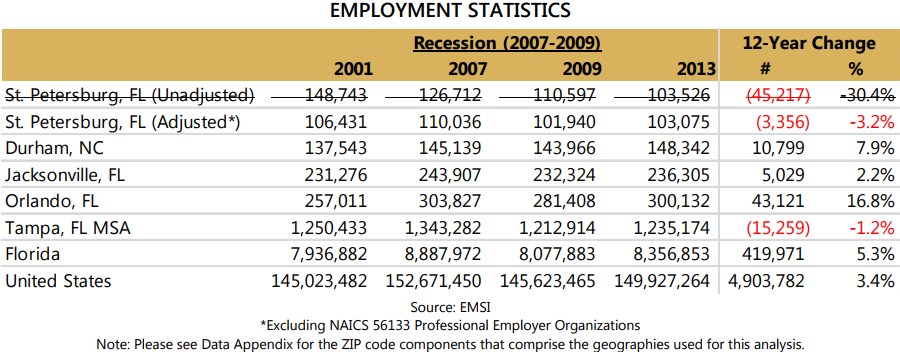
When PEOs – the source of this misrepresentation – are excluded from total employment figures, the employment situation looks much less severe. Even so, St. Petersburg still suffered considerable employment losses over a 12-year period from 2001 to 2013. More than 3,300 jobs were lost in the city, equivalent to 3.2 percent of total employment. While St. Petersburg contains roughly eight percent of all jobs in the metropolitan area, it accounted for roughly 22 percent of all job losses in the metropolitan area from 2001 to 2013. During the Great Recession (2007 – 2009), the city lost nearly 8,100 jobs, a rate of decline (-7.4 percent) that exceeded the rate of recessionary employment losses experienced in the three comparison communities, but that trailed the rate of recessionary employment loss observed across the metropolitan area (-9.7 percent) and the state of Florida (-9.1 percent). However, while the city’s recessionary downswing was not quite as severe as that which was experienced regionally or across the state, its recovery has been more sluggish. Since 2009, the city has recouped just 1,135 of the nearly 8,100 jobs shed the recession, or roughly 14 percent. All comparison communities have recouped at least 34 percent of recessionary employment losses, while the national economy has recouped 61 percent of all jobs shed during the Great Recession.
Taken together, these trends illustrate that St. Petersburg is a community whose true employment situation may be mischaracterized by publicly available and proprietary data sources. However, it is also a community that – even when adjusting for these sources of misrepresentation – is still struggling to emerge from the Great Recession, much like the rest of the metropolitan area. As a result, it has fallen behind in the competition for jobs in the new millennium; while St. Petersburg has lost three percent of its jobs since 2001, the cities of Durham, Jacksonville, and Orlando have experienced rates of job growth between two and 17 percent since 2001.
Founded as a tourism-based economy, the city of St. Petersburg has been sustained over decades by business sectors focused on welcoming travelers and providing them with amenities and entertainment. As the Tampa Bay region grew, the city of Tampa became the “production” town (most famously through the manufacture of cigars), while St. Petersburg focused on services. Certainly, there was, and continues to be, a manufacturing presence in St. Petersburg, but the city has increasingly become a location for multiple service sectors running the gamut from health care to financial to “big data” and home shopping.
Over the 12-year period examined, St. Petersburg has experienced job growth in higher-wage, knowledgebased sectors such as professional, scientific, and technical services; management of companies and enterprises; and health care and social assistance, which are all existing strengths in the city with the presence of major corporations and headquarters. Over the same period, however, the city has lost many jobs in technical and goods producing sectors. It is important to note, though, that not all of these jobs are lower-wage—manufacturing and wholesale trade provide very competitive average wages. Additionally, the city has experienced a decrease in information services and finance and insurance, two important existing strengths, while increasing lower-wage accommodation and food services jobs. Utilities have likewise decreased over time. In 2011, the Tampa Bay Times reported that Duke Energy employed approximately 400 workers in its St. Petersburg location.5 Losses since that time are likely due to the 2012 merger with Duke Energy. Losses in the information sector included the restructuring of the St. Petersburg Times, which led to layoffs starting in 2003, and losses in finance and insurance included widespread layoffs of firms, including Allstate Insurance, Branch Banking & Trust, Mortgage Investors Corporation, and Transamerica Life Insurance.
Location quotients (LQs) are a commonly-used measure for evaluating the composition of a local or regional economy. Location quotients measure the relative concentration of a given sector in a local economy – as measured by its share of total employment – relative to the national average for that same sector. If a location quotient is greater than 1.0 for a given sector, the community has a larger share of employment in that sector than the nation, indicating that such economic activities are more heavily concentrated in that community than the average American community. Firms operating in sectors that are highly concentrated in a given regional often “cluster” because there is some competitive advantage to be derived from that geographic location. Such advantages could include an abundance of a specific labor pool, proximity to key natural assets, or proximity to infrastructure needs such as a port or intermodal terminal, among many other potential advantages.
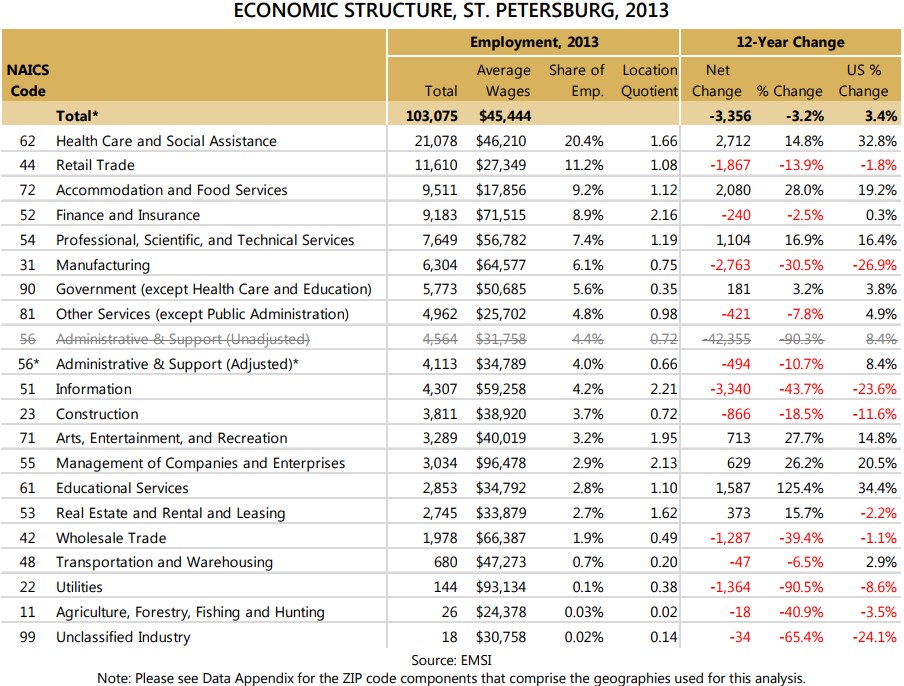
Location quotients reveal some areas of historical strength for St. Petersburg, most notably its legacy sectors of Retail Trade (LQ=1.08), Accommodation and Food Services (LQ=1.12), Arts, Entertainment, and Recreation (LQ=1.95), and Real Estate and Rental and Leasing (LQ=1.62) that are heavily tied to the tourism economy. The community is also home to a strong concentration of more knowledge-based sectors such as Finance and Insurance; Professional, Scientific, and Technical Services; and Management of Companies (Corporate Headquarters). Health Care and Social Assistance is not only the city’s largest employment sector by nearly 10,000 jobs, but is also considerably more concentrated in St. Petersburg than the average American community. Health care services – particularly major hospital systems – are typically concentrated in more urban areas; accordingly, some level of concentration of health care services in St. Petersburg is to be expected. However, at roughly 20 percent of all local employment, health care’s immense economic impact cannot be overlooked.
Many of St. Petersburg’s most concentrated sectors are consistent with the city’s largest employers. Raymond James Financial is headquartered in St. Pete and provides investment and financial planning, investment banking, and asset management to its clients. All Children’s Hospital, located in downtown St. Peterburg, is the only specialty licensed and freestanding children’s hospital on Florida’s west coast and is now in the Johns Hopkins network. Bayfront Health St. Petersburg, located in the same district as All Children’s, is a teaching hospital that has a 15-county medical emergency and trauma helicopter program. The Home Shopping Network – categorized an NAICS 51 Information – is a $3.3 billion firm, while Jabil , which manufactures products and develops supply chain strategies for electronics and technology companies, is a multi-national powerhouse with strengths across multiple sectors.
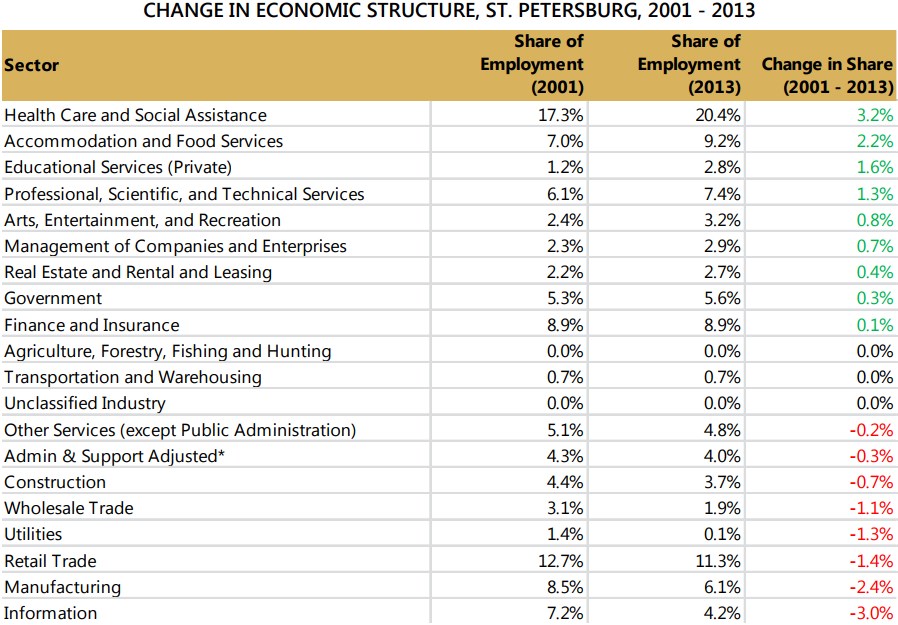
Between 2001 and 2013, a period during which the city lost nearly 3,400 jobs or three percent of its employment base, the community experienced considerable change in its economic structure.
With a few exceptions, the city is very clearly moving towards a more knowledge-based, serviceoriented economy. During the 12-year period, the city shed roughly 4,100 jobs in sectors related to goods production and distribution (manufacturing, transportation and warehousing, and wholesale trade). Those jobs were replaced by a roughly equal gain of nearly 4,300 jobs in health care and social assistance. Given the widespread misperceptions that most manufacturing and distribution-related jobs are low-skill and thus low-wage, many would misperceive this shift away from goods-production and towards health care services as a movement from lower-wage to higher-wage jobs. And while health care is a relatively knowledge-intensive sector with many occupations that pay well above the community’s average wage, the reality is that the average wage for all positions in the manufacturing, transportation and warehousing, and wholesale trade sectors exceeds the average wage across the health care sector.
Certain segments of the community’s tourism-related economy have held up well and strengthened over time. The accommodation and food service (hotels and restaurants) and the arts, entertainment, and recreation sectors have added nearly 2.800 jobs since 2001, increasing their collective share of total city employment form 9.4 percent to 12.4 percent. However, the retail sector – which often tracks closely with the accommodation and food service sector – has shed nearly 1,900 jobs. Although most retail jobs are relatively low-wage, retail sales are an important source of revenues for many local governments. Accordingly, any precipitous decline in retail employment is likely to be accompanied by a corresponding decline in sales tax revenues
When looking at other areas of historical strength for St. Petersburg that are commonly associated with a more knowledge-based, service-oriented economy, it is evident that professional and technical services (including accounting, legal, engineering, research and development, etc.) and the management of companies (corporate headquarters) have become more heavily concentrated while information services (software publishing, data processing and hosting, etc.) has declined considerably.
Overall, the community has experienced a transition that has resulted in the elimination of many jobs associated with goods production and distribution, and the gain of jobs in more knowledge-oriented service sectors. However, there are some important exceptions – most notably the significant decline experienced in information services. The community has shed jobs in some lower-wage sectors associated with travel and tourism, such as retail trade, but added equal numbers in even lower-wage sectors such as accommodation and food service. It has added jobs in the higher-wage professional services and corporate headquarters sectors but shed even more in the higher-wage information services and finance sectors.
But across all sectors, average wages have expanded rapidly in Pinellas County. Given the aforementioned observations regarding change in composition by sector, it is clear that much of this wage growth cannot be attributed to changing economic composition (shifting away from lower-wage jobs to higher-wage jobs); rather, it must largely be attributed to organic growth within sectors. Very simply, employees are experiencing upward mobility in terms of wages at a rate that exceeds that which has been enjoyed by their peers in the comparison communities.
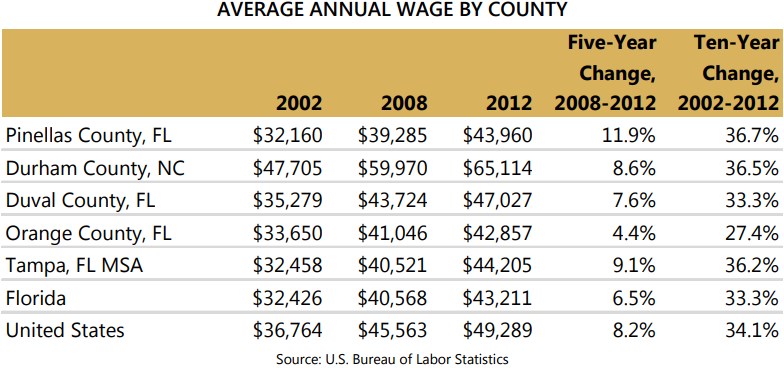
Public input participants were most bullish about St. Petersburg’s opportunities in emerging sectors like “big data” and also its potential to cultivate and leverage a downtown “innovation corridor” spanning employment concentrations in health care and marine science as well as the presence of the University of South Florida St. Petersburg campus. While estimates of the total number of marine science workers and PhDs located at the city’s port varied, there was agreement that St. Petersburg’s marine science industry is one of the most concentrated in the southeast United States and even the nation. With ten agencies, hundreds of PhDs, and $1 billion in infrastructure, the cluster can potentially be economically transformative with the proper support, stakeholders said. This includes opportunities to site research vessels at the port, expand the capacity of USF’s College of Marine Science, and leverage potential synergies between oceanographic research and health sciences innovation at the corridor’s medical establishments. A potential challenge related to expanding a research presence at the Port of St. Petersburg is a ten-year maximum lease period for entities located in the district. A previous referendum to extend the lease term was defeated. More specific data on the city’s economic structure will be included in the Grow Smarter Target Business Analysis.
Bolstering St. Petersburg’s reputation in the marine sciences is the city’s pending hosting of the Blue Ocean Film Festival. Reaching approximately 20,000 filmmakers and scientists and exhibiting film and photography projects by popular media outlets including National Geographic and the Smithsonian Channel, the week-long film festival is one of the largest global environmental documentary film events.
Many stakeholders expressed hope that during this festival, strategic dinners and tours will be employed to develop relationships and stimulate continued interest in St. Petersburg as a prime location for marine sciences.
Opportunities to grow high-value St. Petersburg employment sectors will be examined in much greater detail in the Grow Smarter Initiative Target Business Analysis report, the next deliverable in the planning process.
In the next storyline, we will look at some of the factors that can impact St. Petersburg’s continuing evolution into a more diversified, knowledge-based economy.
Positives
- Wages in St. Petersburg are rising at a rate that exceeds the rate of growth observed in all comparison areas.
- The city has seen job gains in high-paying, knowledge-based sectors such as private health care and social assistance; professional, scientific, and technical services; and management of companies and enterprises (corporate headquarters).
- Tourism-related sectors such as accomodation and food service, and arts, entertainment, and recreation have added jobs since 2001 in St. Petersburg at a pace that significantly exceeds the national rate of expansion.
- Sub-sector data show that job losses in the city are not nearly as significant as what is reported by commonly-cited publicly available and properitary data sources.
Negatives
- St. Petersburg has struggled to emerge from the Great Recession, having recouped a small percentage of the jobs lost between 2007 and 2009.
- The city has shed jobs in some of its areas of historical strength, most notably finance and insurance, and information services.
- St. Petersburg has lost nearly 2,800 manufacturing jobs since 2001, declining at a rate that slightly exceeds the national loss.
- Although it is positive that overall job losses in St. Petersburg are heavily overstated, the misperceptions of these trends could lead observers to make false conclusions about the health of the city’s economy.
Returning to Economic Growth: Competitiveness to Existing and New Businesses
Many U.S. communities are actively pursuing more “21st Century” knowledge-based jobs; the transition that St. Petersburg is experiencing is positive on the surface, but only if the city can stay abreast and even ahead of the competition. This will require a balanced, targeted, and strategic approach to identifying, nurturing, and leveraging the pressure points that will move St. Petersburg’s technology economy forward. This storyline examines some of the most important elements of this transition.
A COMPETITIVE WORKFORCE
Nothing is more important in today’s economy than the skill level of a community’s workforce. It is what technology-focused companies are looking for and they will locate in the places that offer not only the talent to grow their operations but also a training pipeline ensuring that that talent base is sustainable. Transitioning a workforce like St. Petersburg’s from a commodity services model to a technologically sophisticated, knowledge-based model will require time, patience, investment, leadership, perspective, and drive. But the building blocks are there in the thousands of existing technology jobs and steadily evolving entrepreneurial ecosystem in the city.
Workforce Skills
Educational attainment – or the percentage of adults with a Bachelor’s degree or above – is a key indicator of a community’s workforce skill capacity. In knowledge-intensive regions, this percentage is often upwards of 40 percent of the adult population. While the percentage of adults aged 25 and older in St. Petersburg with a Bachelor’s or higher is on par with the national average, the Tampa Bay metro’s rates are slightly lower. In fact, of 366 metros in U.S., the Tampa-St. Petersburg-Clearwater MSA ranks number 158 for adults aged 25 and over with at least a college degree. What this means is that in order to compete for future knowledge-intensive jobs with some of the country’s most talent-rich metros, St. Petersburg will have to import talent from outside the region and improve the retention of local college graduates.
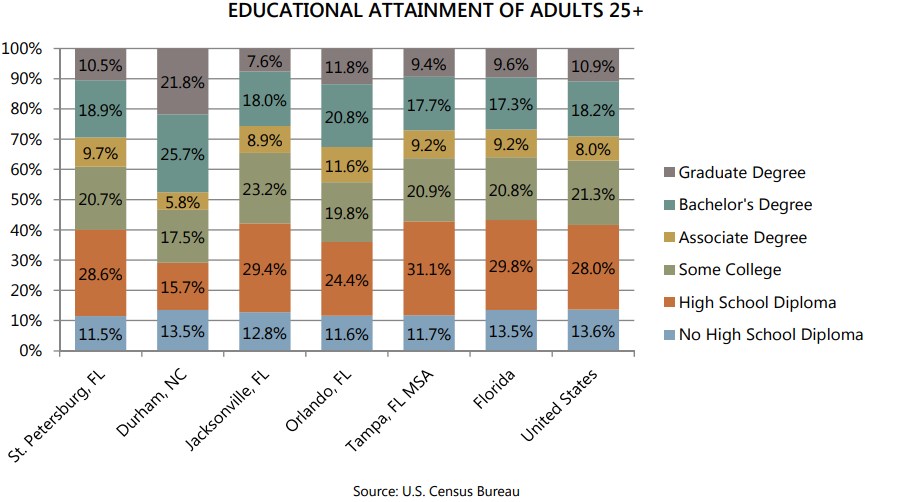
Durham again provides a useful illustration of the competitive realities of pursuing knowledge-based jobs. Nearly half of adults over age 25 possess a college degree or higher, with over one in five earning a graduate degree. In order to play in this league, St. Petersburg and the larger Tampa Bay metro will need to significantly raise regional levels of degree attainment. Encouragingly, St. Petersburg adults aged 25 to 44 have higher levels of educational attainment than the overall adult population; 33.7 percent of these residents have at least a Bachelor’s degree. This figure again exceeds the regional percentage.
Another instructive indicator of a community’s skills capacity is its occupational profile. Different than measures of employment which are staffed positions reported by companies, occupational data is categorized by type of job. This perspective allows for the extrapolation of skills across multiple sectors and provides a better understanding of the portability of an area’s labor pool for new and emerging employment opportunities.
A number of local talent shortages were reported by public input participants. Among these were technical-support engineers, professionals skilled in cyber-science and robotics, and software engineers. According to one technology professional, “We’re still a net importer of talent.” Another said that it was difficult to attract IT workers because, “They don’t know we (St. Petersburg) exist, that’s the problem.” Technology talent is also leery of locating in the city for fear there are no “fall back” positions if their original opportunity were to fall through.
A pervasive deficit of qualified manufacturing talent will only get worse when older workers retire, according to one executive, who added that there is a disconnect between the technological requirements of a modern manufacturing worker and the public perception of these jobs that often dissuades parents and faculty from encouraging students to pursue manufacturing as a career.
Corporate executives and heads of growing companies also noted that attraction of “C-level” talent was also a continuing challenge.
Higher Education Capacity
Ultimately, a community’s goal should be to develop as much talent locally as possible and not rely on the more challenging pursuit of external workers. This strategy also allows business and education leaders to work together to formalize a training pipeline specifically designed for quality jobs being developed in the community.
As the following table shows, institutions in St. Petersburg and its immediate vicinity provide significant degree-granting capacity to regional employers. Only Orlando conferred more degrees from 2011 to 2012 than St. Petersburg. However, reflecting the services-based employment and occupational mix already detailed in this report, St. Petersburg area colleges and universities provided more certificates and two-year degrees than a more technology-intensive economy like Durham, North Carolina.
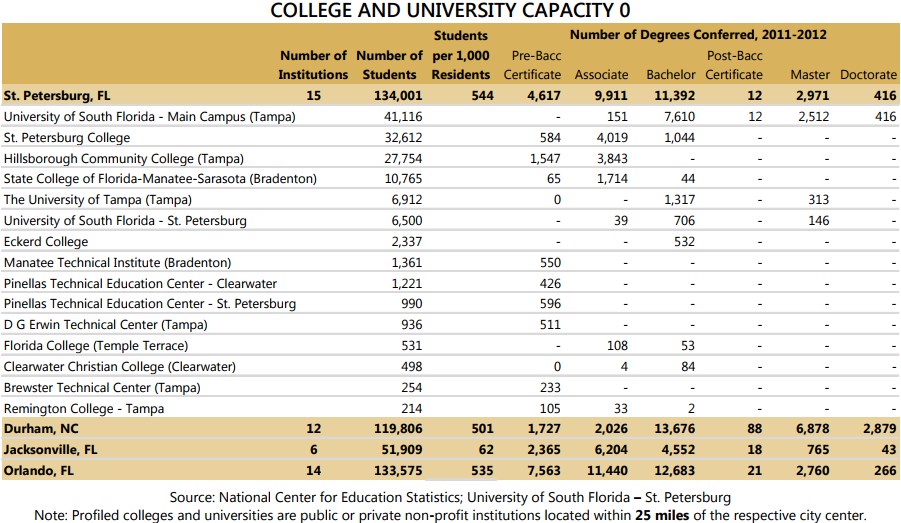
The number of Master’s degrees and doctorates awarded by Durham area institutions is staggering in comparison to the Florida communities and again demonstrates the critical mass of talent needed to sustain an economy dependent on innovation and higher-level processes to fuel its growth.
Amongst the institutions in the St. Petersburg city limits, St. Petersburg College (SPC) has the largest student body and has developed valuable relationships with various businesses, providing specialized training where needed in addition to its many certificate and degree programs. One such relationship is with up-and-coming LED light manufacturer LumaStream, which partnered with SPC on a customized training program to supply a segment of its talent needs. SPC continues to expand its campus, having just broken ground on a $14 million Midtown Center on 22nd Street South in St. Petersburg. Expected to be open by mid-2015, the 45,000-square-foot campus will have a learning support center, library with a children’s area, public meeting space and numerous classrooms, some equipped with laboratory and computer equipment.6
The other large institution within St. Petersburg’s borders is the aforementioned University of South Florida St. Petersburg. With an undergraduate enrollment of roughly 6,500, the fast-growing school recently constructed student housing in an attempt to become a more residential-based campus. In addition to its well-regarded entrepreneurial degree program, USFSP’s online MBA program was recently ranked fourth among Florida universities for Best Online Graduate Business Program by U.S. News and World Report. USF’s College of Marine Science located at the St. Petersburg campus provides a direct pipeline for trained talent in the sector. Graduate programs are offered for biological oceanography, chemical oceanography, geological oceanography, physical oceanography, and marine resource assessment.
USF is not alone in supporting development of marine sciences. Eckerd College also offers undergraduate programs in marine biology, marine chemistry, marine geology, and marine geophysics. Both universities have partnerships with Canterbury School of Florida, a private Pre-K-3 through 12th grade school with two campuses in St. Petersburg. Canterbury has a school-wide marine studies program and has the distinction of being the first Cousteau Divers partner school in the world. Cousteau Divers is a global nonprofit organization dedicated to marine sciences and the legacy of explorer Jacques Cousteau.
Online survey participants had very positive remarks about the level of communication between local universities and businesses. The schools were said to readily assist students with obtaining internships, while businesses were able to work with universities to develop training programs when needed. This feedback was largely corroborated by focus group and interview participants who frequently lauded SPC and USFPC for their contributions to workforce and economic development and downtown/neighborhood revitalization.
Complementing degree-granting institutions is the Tampa Bay Workforce Alliance, comprised of the workforce investment boards of Pinellas and Hillsborough counties. The Alliance is currently developing a skills-gap analysis for “big data” employers after having completed similar studies for the manufacturing and IT sectors.
RESEARCH CAPACITY
It has been said that research universities are the “steel mills of the 21st Century.” Indeed, these campuses – as well as not-for-profit and private research centers and institutions – form the backbone of most innovation and technology-based economies. This is certainly true for Austin, Texas, Raleigh-Durham, Boulder, Colorado, and any number of high-profile innovation-rich communities.
St. Petersburg-based research, as detailed in the previous section, is principally focused on marine science and life/health science. The main members of the marine science research cluster are located in Bayboro Harbor, less than a mile from the USFSP campus and multiple hospitals. All Children’s Hospital, which became a member of the Johns Hopkins Health System in 2011, is the first U.S. hospital outside of the Baltimore and District of Columbia region to be affiliated with John Hopkins. In recent years, the hospital has expanded capacity, most notably through a pediatric residency program which will begin in July 2014.
Researchers participating in public input noted the potential synergies between marine science and medical research. These are principally focused on the connections between marine organisms and habitats and human physiology and disease management. Integrated research can potentially lead to the development of pharmaceuticals and other treatments.
A number of input participants referenced the potential impact of the St. Petersburg Ocean Team (SPOT), a group started by former Mayor Rick Baker including representation from many of the district’s marine science companies, institutions, and organizations. While respondents praised the quality of its membership, they said the group lacks direction. According to one interviewee, SPOT “has intellectual horsepower but no leadership.”
Although an imperfect indicator of a community’s capacity for technology-based economic development, patent awards nevertheless reflect the degree to which intellectual property (IP) is being created in the area. How that IP is leveraged is the next stage of the discussion.
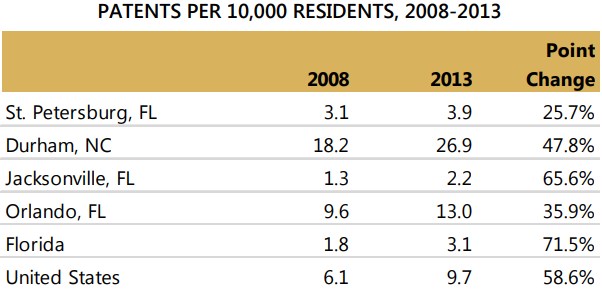
The previous table shows just how far behind St. Petersburg is from its competitors in terms of patentable discoveries. At the city level, only Jacksonville trailed St. Petersburg’s 2013 rate of patent awards. Orlando was over four times more active than St. Petersburg, while Durham was the clear outlier with 26.9 patents per 10,000 residents in 2013.
Patents reflect IP from individuals, private companies, non-profit research centers, and research universities, among others. To get a perspective for the research output of St. Petersburg’s institutional and government-affiliated entities, it is instructive to look at university technology transfer and National Science Foundation (NSF) grant awards. Unfortunately, as is common with many public university systems, tech transfer and IP licensing revenue are not broken out by campus when reporting data to the Association of University Technology Managers. Therefore, while we are able to see total research expenditures for all campuses in the University of South Florida system, we cannot examine the St. Petersburg campus individually. However, as a point of reference, according to the USF-St. Petersburg website, in 2012, the campus was awarded just over $4 million in research funding, only approximately 1.4 percent of the $411 million cited on the USF main campus site. Overall, the USF system is quite competitive with the benchmark institutions in terms of research expenditures, licensing, startup development, and patent issuance. Research can be further fostered at the St. Petersburg campus through collaborations with other organizations and firms, particularly those in the previously referenced innovation corridor of healthcare and marine sciences. There is, of course, always the potential that technology developed at USF in Tampa can be commercialized in St. Petersburg.
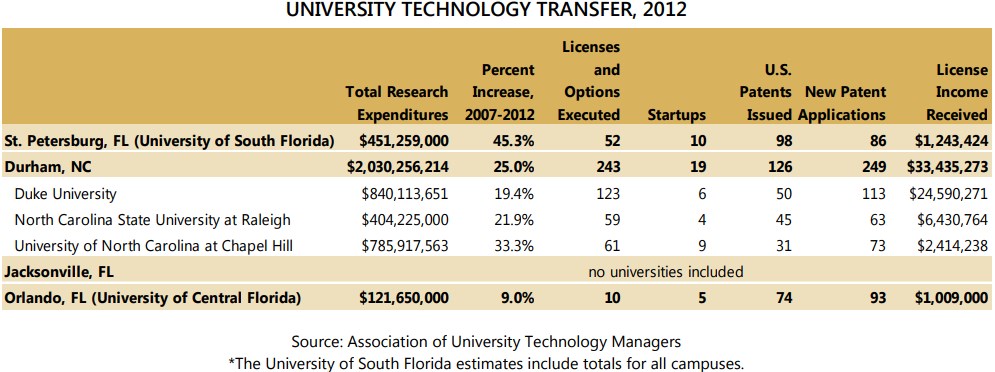
Public input noted that, at least in the past, USFSP was not nimble or savvy when it came to technology transfer processes. Research faculty felt that they had no stake in their intellectual property development and were not allowed to start companies like faculty at more commercialization-focused institutions. In fact, perceived limitations in USFSP’s commercialization system were referenced as a key reason why SRI was attracted to St. Petersburg to incorporate IP developed on campus into their business model. Research faculty were also heavily recruited by SRI to join the team in the company’s new St. Petersburg operations.
Comparative NSF funding, as seen in the following table, provides good perspective on research capacity of the many not-for-profit and government-affiliated research entities in St. Petersburg. In this respect, the city is far more competitive with its peers than patenting or university-sponsored research.
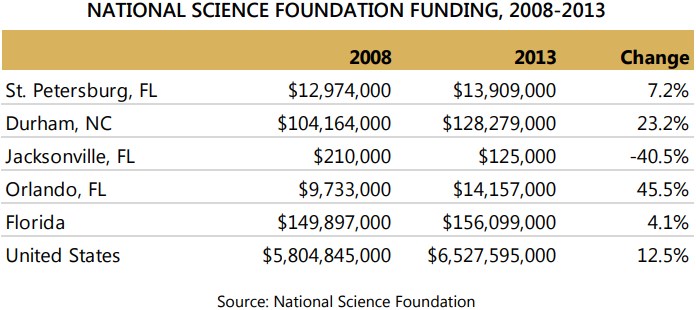
Though still dwarfed by Durham’s fund receipts, St. Petersburg is competitive with Orlando and far exceeds Jacksonville’s NSF awards. In fact, Durham research entities received almost as much NSF funding as the entire state of Florida. While St. Petersburg’s total NSF funding is on par or greater than its Florida peers, the growth of these receipts from 2008 to 2013 trails all the benchmarks except Jacksonville and the state of Florida.
BUSINESS CLIMATE
Business climate is a broad term, but it essentially relates to a community’s cultivated environment for growth. While much in this world is out of our hands, there are other elements that are controllable. Optimizing a local business climate involves limiting disincentives for growth while capitalizing on available tools to support quality job creation.
Business Costs
Tax burden is an important component of business costs and is cited as the cause of many relocations from high-tax states such as California. Florida regularly appears in top business climate rankings because of its lack of a personal income tax, its business-friendly state government, and its access to millions of annual visitors. Its corporate income tax is lower than in North Carolina and neighboring states of Georgia and Alabama. Residents do pay a higher level of property tax than North Carolina, Georgia, and Alabama, but lower when compared to Texas, another state without personal income tax. Florida also has favorable taxes in terms of inventory, beer, and gasoline.
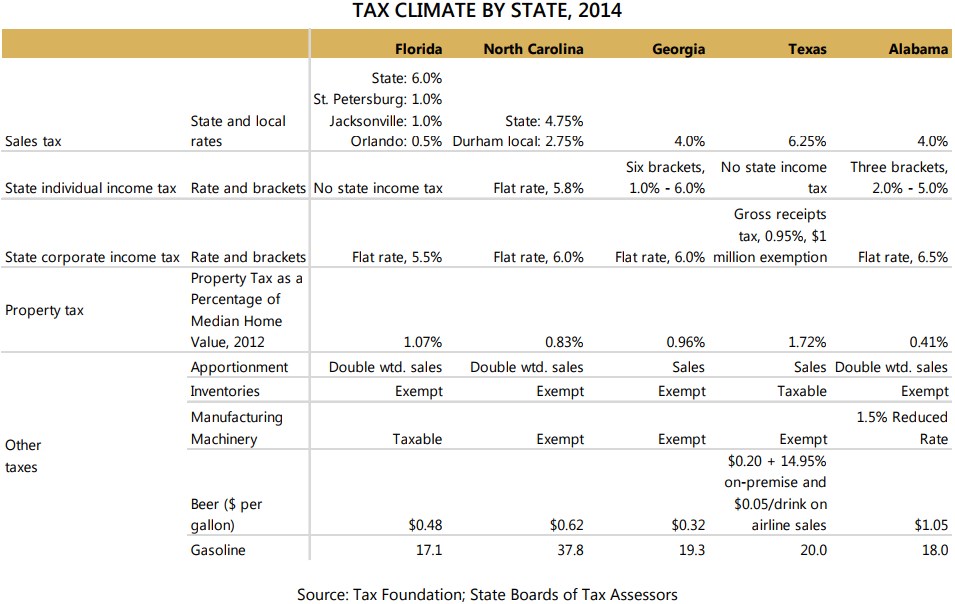
Local tax burden was not an issue that arose during Grow Smarter public input. In fact, the lack of a state income tax and the potential to receive homestead exemptions were actually cited as competitive advantages for St. Petersburg relative to competitor states and cities.
Among the highest rated business climate aspects are state tax climate (3.93), labor costs (3.59), local tax climate (3.49), and government support for business (3.31), rated by survey respondents on a scale from one to five. The lowest rated aspects were insurance costs (2.38), availability of qualified employees (2.87), cost of utilities (3.03), and “business friendliness” of development review process (3.19).
Utility rates are another common business cost concern for companies, especially those in power-intensive industries. As seen in the following table, St. Petersburg’s largest power provider, Duke Energy, is comparatively higher than the benchmark utilities for residential electricity, but equivalent to the largest utilities in the comparison cities for commercial and industrial power.
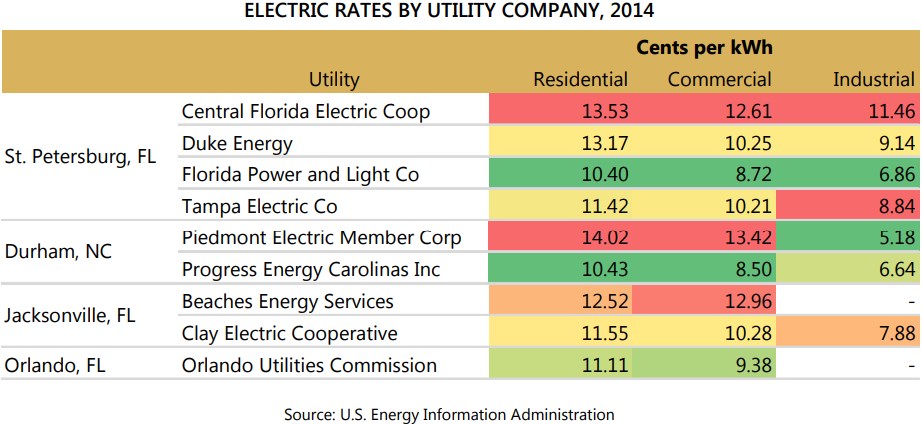
Incentives
The availability of development, expansion, or relocation incentives is leveraged either when a potential project needs public money to justify private investment or when an expansion or relocation project has narrowed down its list of potential investment sites and is looking for a benefit to elevate otherwise evenly matched destinations.
While a number of state and local statutory tools exist to incentivize relocating companies, a recent Tampa Tribune article7 profiled the new tools Pinellas County cities are utilizing to ensure growing companies decide to expand locally. This is especially germane in Pinellas, where, according to the article, “only about 5 percent of the peninsula’s commercial land remains empty and redevelopment costs are high.” In the past two years, St. Petersburg and two other Pinellas cities passed referenda to empower city officials to negotiate tax breaks or property improvements in exchange for hitting agreed-upon job-creation targets. At the county level, Pinellas is reviewing a set of tax breaks and fee waivers they are calling a “regeneration toolbox” to address the reality that much of the county’s industrial property is outdated and only a few large-scale undeveloped parcels exist to support a major expansion. Pinellas is also considering an ad valorem tax exemption similar to one St. Petersburg enacted in 2012. The city’s incentive is industry-sectorspecific and applies only to the city’s share of a property’s taxable value increase for a period of up to ten years.
St. Petersburg can also leverage an alphabet soup of state, federal, and local tools such as Enterprise Zones, Hub Zones, TIF, Urban Job Tax Credits, and others. The city is also assembling continuous tracts of land to offer developers and employers as incentives for investment.
As one government official said in public input, “We can virtually give some of this land away.”
Existing Business Services
A critical component of business climate is the support existing businesses receive to best enable them to retain and grow jobs. Often termed business retention and expansion (BRE) programs, these services are coordinated and implemented by economic development organizations as critical parts of their strategic efforts.
In this vein, the St. Petersburg Area Chamber recently relaunched a program called the Growing Business Council as a tool to facilitate networking opportunities during bimonthly Business Connection Lunches.
While the Chamber does not have staff wholly dedicated to BRE and does not utilize software to build a database of existing business information, the Pinellas County economic development office conducts existing-business visits and provides monthly reports to regional partners in addition to maintaining an inventory of development sites to inform prospect development and negotiations. The city of St. Petersburg also has an active economic development and planning office that cultivates relationships with existing employers.
In public input, certain businesses said more could be done to ensure that their competitive issues are understood and managed. Some would like to see more frequent and focused existing business visits, while others said they would be interested in serving as “ambassadors” for St. Petersburg with corporate prospects if asked.
On the survey, business owners were asked how likely their business will remain in St. Petersburg for the long term. The response was favorable, with an average rating of 3.99 of five total points. To “My business receives the support from economic development organizations it needs to grow,” business owners responded with an average of 3.03, slightly higher than the 2.92 rating for government support.
Regionalism
More often associated with marketing than business climate, the concept of regionalism nevertheless helps establish a tone for cooperation and communication across city and county lines. Intra-regional governments that are seen as hostile to each other are often red flags for companies looking to locate or expand in the community or site consultants comparing regions for clients. While truly seamless regional partnerships are rare, there are nevertheless metro areas that strive to speak with one voice on key issues and initiatives.
In the Tampa Bay region, the two population centers on either sides of the Bay have long been seen internally and externally as adversarial. Historically different both demographically and economically, St. Petersburg and Tampa have not always seen eye to eye on issues as diverse as major league baseball and transportation. However, there are issues that serve as uniters between regional governments, principally including Tampa International Airport, but also Port Tampa Bay and, more recently, Greenlight Pinellas. The issue of better connecting the region is paramount for many public and private officials from across Tampa Bay.
Founded in 1994, the Tampa Bay Partnership serves as the external marketing entity for the eight-county region inclusive of Citrus, Hernando, Hillsborough, Manatee, Pasco, Pinellas, Polk, and Sarasota counties; the Partnership also encompasses nearly 150 public and private businesses and 11 local and sub-regional economic development organizations. In addition to marketing, the Partnership also coordinates programming in transportation, baseball (keeping the Rays in Tampa Bay), public policy, talent development, and community wellness.
St. Petersburg’s relationship and impact on Tampa Bay Partnership efforts was adversely affected by difficulties the St. Petersburg Area Chamber experienced prior to its renewal under its current leadership. Regional partners are now looking for the Chamber, in addition to the city of St. Petersburg and Pinellas County, to become more engaged in regional efforts and communicate the “story” that they want to be told nationally and internationally.
Tampa/Hillsborough’s support of Greenlight Pinellas is seen as a potential game-changer for regional relations by many public input participants. This is bolstered by the recent joint press conference in support of the transit referendum by the mayors of Tampa and St. Petersburg. As one interviewee said, “You hear ‘Tampa Bay Area’ more these days, but it’s still fragmented. There’s a lot of parochialism from both sides.” However, another participant noted that “there’s a lot of cooperation that’s not being recognized.” One business leader commented, “The big challenge for St. Petersburg is getting over the provincialism and insecurity vis a vis Tampa. There’s greater vitality if we’re part of a larger regional economy.”
Survey respondents were asked what differentiates St. Petersburg from the city of Tampa. Responses were both positive and negative. One respondent noted, “A beautiful waterfront and lack of traffic congestion. Plus nicer residents.” Another offered, “The communal pride us residents have. It’s a livable city, not a commuter city.
ENTREPRENEURSHIP
The reality is that the vast majority (upwards of 80 percent according to some studies) of a community’s jobs are created by existing companies, including small businesses. Thus, programs to seed, launch, nurture, and expand small businesses and entrepreneurial enterprises are de facto economic development needs for places large and small. Especially in recent years, the concept of support for entrepreneurs and startup businesses has become all the rage in economic development circles. Communities are building and staffing incubators and accelerators as fast as possible and claiming that they have established an entrepreneurial “ecosystem.” Unfortunately, becoming a true entrepreneurial economy requires factors that may be manageable (availability of capital, inclusive leadership, place-based amenities attractive to young professionals, entrepreneur-led event programming and networking) or beyond a community’s control (presence of a major research university, mild climate, beaches and mountains, major international airport, etc.).
Encouragingly for St. Petersburg, the stars are beginning to align for its entrepreneurial economy. One input respondent said the city is “an ideal epicenter for developing the regional technology ecosystem.” Reasons cited included a nearby university, arts and cultural vitality, a walkable, vibrant downtown attractive to the “Creative Class,” and a beach lifestyle that could draw investors and entrepreneurs from across the country. The respondent added, “We have the elements of becoming another Boulder. Light rail would be huge.” Another said that a key catalyst for spurring the development of St. Petersburg’s ecosystem was the opening of The Greenhouse – a partnership between the City of St. Petersburg and the St. Petersburg Area Chamber – as a venue for entrepreneurs to meet, network and host events.
The Greenhouse, located in a renovated historic building in Downtown St. Petersburg, serves as a “onestop shop” for many programs and services supportive of startup enterprises and entrepreneurs. On site staff from the City of St. Petersburg and the St. Petersburg Area Chamber of Commerce work with clients to assist them with opportunities to grow or locate their business in the city. Mentorship services are provided through partnerships with organizations such as SCORE and ASPEC (Academy of Senior Professionals at Eckerd College) as well as through relationships with area business leaders. The City/Chamber collaboration also allows entrepreneurs and small business people to promote events and accomplishments of their companies across a broad network of firms and influencers. Opportunities also exist to help companies host ribbon-cutting events.
A core tenet of the Greenhouse is to provide entrepreneurs and business owners with access to educational resources such as the fundamentals of starting/running a business as well as information about new and innovative growth practices. Funding is a critical programmatic component of the Greenhouse. Through its network of partners, the organization provides access to financial institutions and experts that can help businesses improve their chances of securing financing. Perhaps the most critical role of the Greenhouse is to facilitate relationship-building amongst St. Petersburg’s private sector. Whether through in-house “office hours” from top business people or events like the Kauffman Foundation’s 1,000,000 Cups, the Greenhouse facilitates connections and collaborations in the area’s business and entrepreneurial ecosystems.
Another potential anchor for St. Petersburg’s entrepreneurial economy is set to come online later in 2014. TEC (Technology Entrepreneurship Center) Garage St. Petersburg will be a 6,000 square foot incubator located in the ground floor of St. Petersburg College’s downtown campus. The facility will be run by the staff of the Largo-based Tampa Bay Innovation Center and operate on a three-year lease. TEC Garage will be funded by $400,000 set aside by state legislators in 2013. The Innovation Center’s CEO said that TEC Garage will be a smaller and “near-term” incubator that will one day complement a larger and permanent downtown facility, potentially with wet lab space to accommodate biotechnology businesses.8
USFSP is also a key player in the development of St. Petersburg’s entrepreneurial ecosystem. The school’s nationally recognized entrepreneur program is up to 85 students and growing. Gazelle Lab, an accelerator program affiliated with USFSP faculty, has been a catalyst in the launch of three established companies and enables the university’s entrepreneurship students to serve as consultants and interns in the program. Gazelle Lab was the first university-affiliated accelerator to be run by TechStars, a pioneer of the acceleration concept and operator of the nation’s largest network of affiliated programs. Gazelle Labs is also now part of the Global Accelerator Network.
A look at the numbers provides a comparative perspective on the dynamics of St. Petersburg’s entrepreneurial economy. As seen in the following table, there are 5,107 identified self-employed (see Appendix C: Data Sources for definition) workers in St. Petersburg, comprising 4.9 percent of the city’s total economy, a lower rate than the national figure of 6.6 percent. However, the self-employed in St. Petersburg earn slightly more than the national average at $25,917 per year.
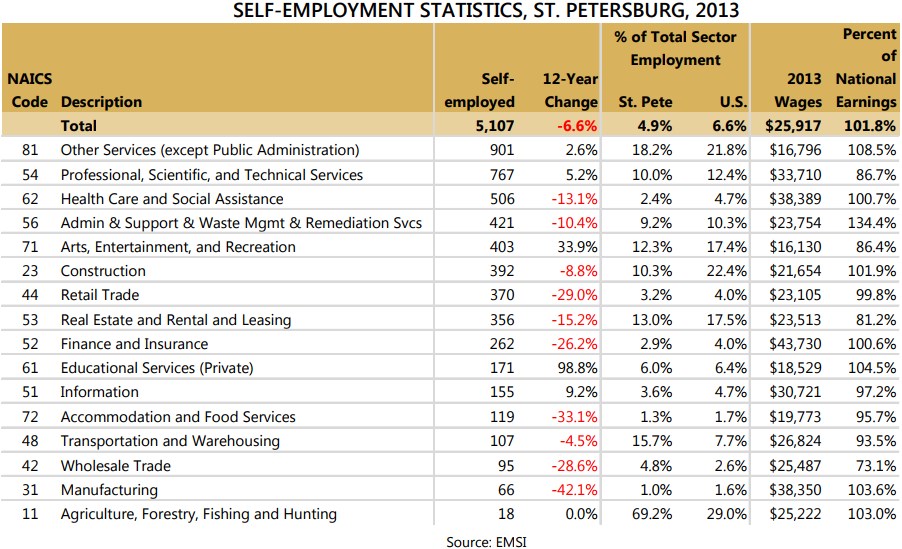
Despite an overall decline in self-employment from 2001 to 2013, there are several sectors that are more concentrated in St. Petersburg than they are in the average American community, including information (LQ = 2.26), finance and insurance (2.07), professional, scientific, and technical services (1.29), and health care and social assistance (1.12). These are consistent with the city’s economy as a whole and its transition away from service-based jobs to knowledge-driven employment.
Availability of capital is one of the principal concerns of any entrepreneurial economy and a prime differentiator of dominant startup communities like Silicon Valley and underperforming areas. Capital formation is comprised of numerous types, including proof-of-concept, seed, bridge, venture, and angel financing, but the overall purpose of investment at any stage of an enterprise’s development is to ensure that the capacity exists to take an idea successfully to market and scale it for maximum return.
Looking at small business loan data published under Community Reinvestment Act regulations provides perspective on one potential source of enterprise-development financing. Data for Pinellas County in the following table (data not available at the city level) shows that Pinellas has more loans per capita than the comparison counties, but on average lower loan amounts.
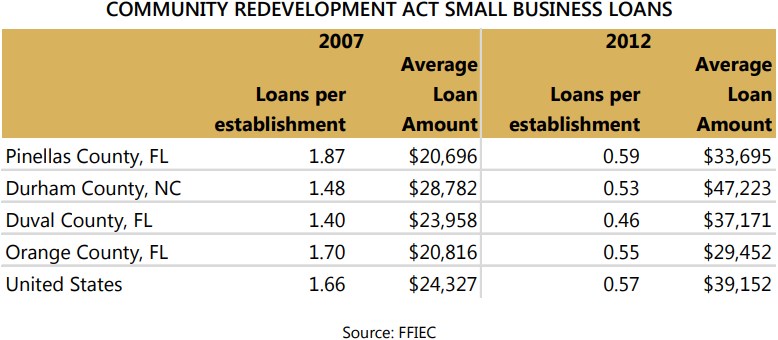
Public input participants were not complimentary of St. Petersburg’s capital-formation capacity, noting that there is ample private equity in the community, but limited venture and angel financing. According to one entrepreneur, “The capital markets are horrible here. It’s one of the biggest challenges of this area.” Lack of financing at multiple stages of the startup cycle risks new enterprises “launching here and leaving.” Even so, other respondents said funding prospects are looking up in the community. According to one serial entrepreneur, in the last six months people with resources have approached leaders of the ecosystem and said, “We want to invest.”
One potential source of capital is the St. Petersburg Downtown Partnership (SPDP). The non-profit organization focuses mainly on advocacy and public planning issues, but occasionally makes direct investments in local startups with the potential for high-paying job creation. A recent $20,000 investment in mobile-funding company SavvyCard was the second made by the SPDP, following a $25,000 investment in smart-LED startup LumaStream in 2012. The selection of potential investment opportunities is done on a case-by-case basis.9
Survey respondents were asked to rate an array of components of St. Petersburg’s entrepreneurial climate. Among the most favorable were availability of talent, which is considered strong or very strong by 42.5 percent of respondents, entrepreneur-focused events and meetups (42.4 percent), small business development support (32.9 percent), and mentorship opportunities (29.5 percent). The lowest rated were availability of seed loans, which 58.8 percent of respondents consider weak or very weak, availability of angel investment (59.6 percent), availability of venture capital (55.4 percent), acceleration programs (46.3 percent), and incubation facilities (49.5 percent). Survey respondents would like to see a more streamlined startup process, more opportunities for learning and training, and more exposure for youth about entrepreneurship.
TRANSPORTATION AND INFRASTRUCTURE
Despite the prevalence in current economic development circles to talk about the competitive priorities of place-based lifestyle amenities and entrepreneurial incubation facilities, the reality is that some of the traditional concerns related to physical infrastructure capacity still matter when it comes to corporate location decisions. Throughout its history, the city of St. Petersburg has experienced accessibility challenges due to its location on a narrow peninsula straddling a bay and ocean channel. Early breakthroughs came with the extension of a rail line to the city as well as the construction of bridges east to Tampa and south to Palmetto. Now, the city has access to Class I rail, two ports, three airports, and multiple federal interstates and state and federal highways.
However, while there are no deficiencies from an economic infrastructure standpoint in any of these areas, the city’s position southeast of Port Tampa Bay and in the Southeastern corner of the United States means that it is not a particularly attractive location for manufacturing and distribution, with the possible exception of goods being produced and exported in high volume to the Caribbean, Central America, and other common export destination for goods leaving Port Tampa Bay
Highways and Roads
While traffic congestion and east-west connectivity were cited often in public input as concerns, data show that commute times for St. Petersburg residents are competitive relative to the metro average and Florida peers. Just over a quarter of St. Petersburg residents spend more than 30 minutes traveling to work compared to 37.7 percent metrowide, 30.5 percent in Orlando, and 29.8 percent in Jacksonville.

A series of ongoing improvements to U.S. 19 in Pinellas County has improved access into north St. Petersburg, while work will begin in 2017 on a five-year, $337 million expressway project linking I-275 to U.S. 19 with elevated tollways, easing a long-time chokepoint for travelers entering the city from the east. The so-called Gateway Express project also includes a link from I-275 to the St. Petersburg-Clearwater Airport.
As noted, public input respondents expressed frustration that the “further north you go in Pinellas County,” the harder it is to cross the peninsula east-west. One respondent said that there is not a “coordinated network” to get people in and out of St. Petersburg. Another noted that the Skyway Bridge is becoming a barrier for ingress and egress of large cargo ships in Tampa Bay.
One stakeholder suggested that St. Petersburg and Tampa work together to provide hourly ferry service to connect the two downtown areas, which would also connect resources and provide visitors greater access to regional amenities.
Rails
St. Petersburg is served by one Class I rail line owned by CSX. Of the comparison cities, only Durham and Jacksonville are served by a second Class I system. When compared with major distribution hubs such as Memphis, Dallas, Kansas City, Atlanta, and others, St. Petersburg’s capacity and connectivity pales in comparison. Many of these locales are served by up to four, and even five Class I lines.
Therefore, combined with its geographical location in the southeastern corner of the country, it is unlikely that St. Petersburg and Pinellas County will become a major multi-modal distribution hub. This is especially true because of the lack of large-scale development sites that would accommodate these facilities. Large scale development sites near the city’s Class I rail infrastructure would be an important asset for the city to leverage.
Water Ports
The recently re-named Port Tampa Bay (to reflect its regional presence) serves as a major processing and distribution center, especially for steel, and is a part of Foreign Trade Zone #79. The largest cargo tonnage port in Florida, in fiscal year 2013, Port Tampa Bay reported handling 34.9 million tons of cargo, 2,988 vessel arrivals, and over 850,000 cruise passengers. The deepwater port is currently adding a new terminal specifically for importing and exporting automobiles, opening up lucrative new markets in Latin America and the Caribbean.
The Port of St. Petersburg is located on the city’s downtown riverfront and primarily serves cruise ships. As noted earlier in this report, many feel the Port could be leveraged more aggressively for economic development if a ten-year maximum lease provision is extended. This would require a public referendum to change, and an effort that has been defeated in the past.
Airports
St. Petersburg’s three accessible airports are Tampa International – by far the largest of the three – St. Petersburg-Clearwater International, and Alfred Whitted Municipal Airport, located downtown. Whitted does not serve commercial travelers.
Tampa International ranks 27th in the nation for passenger departures. From 2012 to 2013, St. Petersburg and Tampa were the only airports of the comparison geographies that experienced an increase in passenger departures. In terms of freight cargo capacity, Tampa International ranks 44th in the nation.

The increase in the St. Petersburg Clearwater International Airport’s passenger traffic is attributed to Allegiant Airlines launching service to six new destinations in fall 2013, including Columbus, OH; Elmira, NY; Fargo, ND; Sioux Falls, SD; Stewart International Airport, near Newburgh, NY; and Syracuse, NY. Year-todate passenger numbers are up 25 percent from 2013.
The increase in the St. Petersburg Clearwater International Airport’s passenger traffic is attributed to Allegiant Airlines launching service to six new destinations in fall 2013, including Columbus, OH; Elmira, NY; Fargo, ND; Sioux Falls, SD; Stewart International Airport, near Newburgh, NY; and Syracuse, NY. Year-todate passenger numbers are up 25 percent from 2013.
As with the Port of St. Petersburg and Al Lang Field, many stakeholders feel that Whitted Airport is not the highest-and-best-use for prime downtown waterfront property. Nevertheless, all efforts to free up the property for redevelopment have failed resoundingly at the polls. In addition, millions of dollars have been invested at Whitted in a new terminal, while runway-expansion plans are currently underway. Input respondents feel the redevelopment of Whitted is a “dead issue” and would not pass any referendum to convert the site to non-airport uses.
Positives
- St. Petersburg area colleges and universities provide significant training capacity to regional employers. Universities and businesses feel they are effective collaborators.
- Marine science is a major opportunity area for St. Petersburg with several existing research, support and training organizations and partnerships already in place.
- St. Petersburg has competitive capacity relative to its comparisons in terms of not-for-profit and government-affiliated research. Despite some deficiencies when compared to top local innovation economies, research is on the rise and St. Petersburg has a ripe opportunity to leverage these resources in the burgeoning downtown innovation district.
- Florida has a favorable business climate, as noted by public input respondents, with business-friendly tax structures and recent regulation cuts at the state level. Stakeholders consider the tax climate a competitive advantage to businesses.
- St. Petersburg has an entrepreneurial spirit, while its quality of life is a major asset for young professionals and business owners. Small business development support received high ratings, in part due to best practice programs such as the Greenhouse.
- St. Petersburg has access to Class I rail, two ports, three airports, and multiple federal interstates and state and federal highways.
- Despite public input identifying transportation as a challenge, commute times are competitive when compared to peer communities; multiple projects underway in Pinellas County are poised to provide continued improvements.
- Although there is very limited land for new developments, there are promising opportunities for redevelopment.
Negatives
- St. Petersburg has to be proactive in ensuring that it can provide talent well-matched to its economy. Although the percentage of St. Petersburg’s adults with at least a bachelor’s degree is on par with the nation, educational attainment levels for the Tampa region are uncompetitive, especially as St. Petersburg transitions to more knowledge-based jobs
- Availability of capital is a major issue for the city’s tech ecosystem; stakeholders have identified lack of angel investment, seed loans, and other forms of capital as key needs
- St. Petersburg must raise its capacity to be competitive for research output at the university level. Its patent production trails all comparisons except Jacksonville, while Durham area universities have invested over five times USF’s amount in research expenditures.
- Although the city has strong infrastructure assets, its location inhibits attractiveness for large-scale manufacturing and distribution growth.
Conclusion
In many ways there is a dichotomy between residents’ attitudes and perceptions of St. Petersburg and what data show as the city’s recent economic and demographic trends. In some instances, the perception lags behind reality, such as pervasively negative views about the public school system despite recent improvements in both programming and performance results. In other instances, attitudes are optimistic despite data indicators. There is a tangible sense of renewal in the minds and attitudes of many stakeholders who tout St. Petersburg’s downtown renaissance, great quality of life, walkability, revitalizing neighborhoods, arts scene, Fortune 500 companies, innovation and entrepreneurship opportunities, and other factors as signs that the city is poised to become Tampa Bay’s community of choice and a magnet for talent and companies from the southeast and beyond. But numbers paint a more concerning picture, one of a community losing residents and jobs and struggling with high crime rates and persistent poverty.
Despite certain of these trends, there can be no denying that St. Petersburg is in a much better position than in years past when many residents said they could not see themselves remaining in the city long-term and downtown was a ghost town in the evening hours. The ultimate direction St. Petersburg’s growth trajectory will take may well be dependent on resolving long-standing divisions between the haves and have-nots in the city and groups of different racial and ethnic backgrounds. The city “divided between downtown and everywhere else” may need to become a city united for truly sustainable population and job increases to take hold.
This Grow Smarter Initiative process will go a long way towards identifying the key strategies that will position St. Petersburg to return to net-positive residential and employment growth. It will not happen overnight, but neither is the city starting from scratch in its evolution as a top destination for talent and investment. Buzz is building and momentum is strong. The next stage is ensuring that trend data matches the sentiments of St. Petersburg residents and businesses about the city’s future prospects.
Key Takeaways
The following represent the principal findings from the quantitative and qualitative research conducted for this Competitive Assessment.
- St. Petersburg’s leadership dynamic is gradually transferring to a new generation. Data show that a shift is occurring in the city as the percentage of young professional residents grows and they become more involved in political and community affairs. While tensions between younger and older cohorts may continue to play out over key issues and referenda, the “new normal” in St. Petersburg may be a younger-skewing outlook on the city’s future direction.
- Opportunities to further diversify St. Petersburg’s economy away from hospitality and tourism are encouraging, but key challenges remain. As analysis of the city’s changing economic structure confirm, a number of its fastest-growing sectors are knowledge- and technology-categories that pay strong wages and attract and retain top talent. But competition for these jobs is fierce, and St. Petersburg must enhance its workforce competitiveness and innovation capacity to truly capitalize on these opportunities. The benefits of this changing economy must also be more equitable to those residents still struggling under the burdens of poverty.
- St. Petersburg’s development patterns, walkability, density, and traditional character are in full alignment with the preferred destination of today’s highly skilled young professional workforce. One entrepreneur after another said it: St. Petersburg features the type of lifestyle and built environment sought by highly mobile technology companies and workers. Now the challenge is to not only continue nurturing the development of these districts but also actively promote what St. Petersburg has to offer.
- Downtown St. Petersburg is approaching a critical mass of destinations and amenities that creates real possibilities of extending the district’s momentum further into the city’s neighborhoods. In order to stimulate and sustain comprehensive neighborhood-improvement strategies, local stakeholders must address the perception, reality, or both of St. Petersburg’s public education system and housing stock.
- Though still in its early stages, a dynamic entrepreneurial ecosystem is forming in St. Petersburg that can be transformational for the city’s economy. Much work must still be done to develop a critical mass of assets needed to become a top entrepreneurial economy. These include additional options for funding new enterprises at all stages of their growth, creating more spaces and places for established and fledgling entrepreneurs to meet and network, and expanding the awareness of St. Petersburg’s burgeoning status as fertile ground for startup development.
- Local and regional divides must be breached for St. Petersburg to reach its true economic potential. Internally, historical and current frictions between residents of different races, ethnicities, and incomes must continue to be addressed so that all city constituents share in its success. Externally, St. Petersburg must acknowledge that a stronger, more united Tampa Bay is to the benefit of governments across the region and act accordingly through sustained outreach and development of new partnerships and programs.
This Competitive Assessment is only the first of a multi-phase process to determine a vision and strategic roadmap for St. Petersburg to pursue along its journey to quality growth. Future components include research and recommendations on the city’s most competitive target business sectors, analysis of current and potential marketing activities, and a strategy and implementation plan leveraging all the process’ research to position St. Petersburg for quality future growth to benefit both the city and Tampa Bay region.
